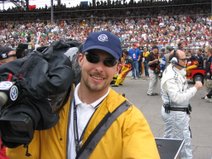Local radio personality Troy Neff was stabbed during a road rage altercation last night. Here is the raw interview Troy gave to Alexis Means today that I shot.
STANDBY="Loading Windows Media Player components..." TYPE="application/x-oleobject">
WIDTH="192" HEIGHT="190" ShowControls="1" ShowStatusBar="0" ShowDisplay="0" autostart="0">
Thanks for watching.
-Billau
Friday, December 12, 2008
Wednesday, November 19, 2008
More Extreme Home
Wow, I've had over 500 hits in the last 24 hours. I talked with Diane and we decided that the entire raw walk-through disk should be posted. It's about 45 minutes worth of video, so I had to chunk it down into four parts (our server almost choked when I tried to send it all at once). There was a lot of material we had to pick through to put in Sunday's story. Some of the stuff we left out because we thought ABC would include it in their show. Some of what you'll see has already been used in the previous package, the other 35 minutes or so is never before seen. Anyodd, here is our tour in its entirety (in four parts).
Part 1
STANDBY="Loading Windows Media Player components..." TYPE="application/x-oleobject">
WIDTH="192" HEIGHT="190" ShowControls="1" ShowStatusBar="0" ShowDisplay="0" autostart="0">
Part 2
STANDBY="Loading Windows Media Player components..." TYPE="application/x-oleobject">
WIDTH="192" HEIGHT="190" ShowControls="1" ShowStatusBar="0" ShowDisplay="0" autostart="0">
Part 3
STANDBY="Loading Windows Media Player components..." TYPE="application/x-oleobject">
WIDTH="192" HEIGHT="190" ShowControls="1" ShowStatusBar="0" ShowDisplay="0" autostart="0">
Part 4
STANDBY="Loading Windows Media Player components..." TYPE="application/x-oleobject">
WIDTH="192" HEIGHT="190" ShowControls="1" ShowStatusBar="0" ShowDisplay="0" autostart="0">
Thanks for watching!
-Billau
***One of the engineers at our station told me he had had some trouble watching the video from home. I don't know a whole lot about computers, but I know some of the older computers out there can't run the type of media player this video comes from. If you have a newer computer, you should be okay. Like I said, I don't know computers, I just take pictures.
Part 1
STANDBY="Loading Windows Media Player components..." TYPE="application/x-oleobject">
WIDTH="192" HEIGHT="190" ShowControls="1" ShowStatusBar="0" ShowDisplay="0" autostart="0">
Part 2
STANDBY="Loading Windows Media Player components..." TYPE="application/x-oleobject">
WIDTH="192" HEIGHT="190" ShowControls="1" ShowStatusBar="0" ShowDisplay="0" autostart="0">
Part 3
STANDBY="Loading Windows Media Player components..." TYPE="application/x-oleobject">
WIDTH="192" HEIGHT="190" ShowControls="1" ShowStatusBar="0" ShowDisplay="0" autostart="0">
Part 4
STANDBY="Loading Windows Media Player components..." TYPE="application/x-oleobject">
WIDTH="192" HEIGHT="190" ShowControls="1" ShowStatusBar="0" ShowDisplay="0" autostart="0">
Thanks for watching!
-Billau
***One of the engineers at our station told me he had had some trouble watching the video from home. I don't know a whole lot about computers, but I know some of the older computers out there can't run the type of media player this video comes from. If you have a newer computer, you should be okay. Like I said, I don't know computers, I just take pictures.
Sunday, November 16, 2008
Extreme Home
Diane Larson and I were given a tour of Jackie and Aaron Frisch's new home last week and Diane's story will air tonight during the 11 PM newscast. The original piece was nearly 6 minutes long...far too long to fit in a half-hour newscast. Below is the original piece in its entirety.
STANDBY="Loading Windows Media Player components..." TYPE="application/x-oleobject">
WIDTH="192" HEIGHT="190" ShowControls="1" ShowStatusBar="0" ShowDisplay="0" autostart="0">
Thanks for watching!
Billau
STANDBY="Loading Windows Media Player components..." TYPE="application/x-oleobject">
WIDTH="192" HEIGHT="190" ShowControls="1" ShowStatusBar="0" ShowDisplay="0" autostart="0">
Thanks for watching!
Billau
Thursday, October 23, 2008
The Liberal Media
Yesterday I covered the Sarah Palin rally in Findlay, Ohio. It's been a while since I've covered a big Republican event, but it didn't take long for me to remember how some of the rank and file GOP treat local media. I remember covering the GOP victory party in 2004 in downtown Toledo. Some smart guy walked up to me as I was setting my camera up and told me that he only watches FOX News Channel because they're fair and balanced. Rant to follow.
I digress. As I moved through the metal detectors I hear from behind, "Oh look, it's the regular liberal media." Good for you skippy, you saw Saturday Night Live last weekend.
Before the governor spoke, a number of former and current GOP elected officials spoke. Former Attny. General Betty Montgomery, Senator George Voinovich, and Attny. General candidate Mike Crites all referenced the "Liberal Media" in one way or another. Montgomery referenced us with, "Hollywood and the liberal media."
Thank you Rush Limbaugh, Glenn Beck and Sean Hannity. I get it. Some of the media out there leans to the left. We all know it now. I don't disagree.
The final straw was when I went to buy a button for my dad after the rally. I was still wearing my photographer's vest and I had my ABC media ID around my neck. "Are you going to try to be fair to us for a change? It might be tough for you being part of the liberal media," the lady selling the buttons said to me. I'd had it. I was going to give her my money for something she was selling and that's how I was greeted. After I talked to her for a few minutes, she told me she was sorry and never thought about it that way.
Here's part of what I told her:
I'm sick of being harassed at these events because I work in news. You have no idea where I or the rest of my colleagues stand politically. You might be surprised. If you want to be pissed off at somebody, be pissed off at those photographers and reporters go running into the events minutes before the candidate takes the stage. Those are your national media and traveling press. Don't take your frustrations out on the local media photographers and reporters. When was the last time you saw a hit piece done on either candidate by a local television station. You haven't because we don't do it. In fact, I think we bend over too far so as not to be perceived as biased one way or another. The brass here is constantly sending out emails reminding us that, "We must present an image of impartiality." We locals are not to be happy for those who won, nor are we to be sympathetic to those who lost. When covering a candidate's visit, a local station's coverage will go something like this...
1. This candidate came to town.
2. This is what the candidate had to say.
3. This is what people who saw the event thought of what he/she had to say.
Does the liberal media exist? You know the answer. And if your answer is "yes," just remember not to take it out on your local guys.
Thanks for watching.
-Billau
I digress. As I moved through the metal detectors I hear from behind, "Oh look, it's the regular liberal media." Good for you skippy, you saw Saturday Night Live last weekend.
Before the governor spoke, a number of former and current GOP elected officials spoke. Former Attny. General Betty Montgomery, Senator George Voinovich, and Attny. General candidate Mike Crites all referenced the "Liberal Media" in one way or another. Montgomery referenced us with, "Hollywood and the liberal media."
Thank you Rush Limbaugh, Glenn Beck and Sean Hannity. I get it. Some of the media out there leans to the left. We all know it now. I don't disagree.
The final straw was when I went to buy a button for my dad after the rally. I was still wearing my photographer's vest and I had my ABC media ID around my neck. "Are you going to try to be fair to us for a change? It might be tough for you being part of the liberal media," the lady selling the buttons said to me. I'd had it. I was going to give her my money for something she was selling and that's how I was greeted. After I talked to her for a few minutes, she told me she was sorry and never thought about it that way.
Here's part of what I told her:
I'm sick of being harassed at these events because I work in news. You have no idea where I or the rest of my colleagues stand politically. You might be surprised. If you want to be pissed off at somebody, be pissed off at those photographers and reporters go running into the events minutes before the candidate takes the stage. Those are your national media and traveling press. Don't take your frustrations out on the local media photographers and reporters. When was the last time you saw a hit piece done on either candidate by a local television station. You haven't because we don't do it. In fact, I think we bend over too far so as not to be perceived as biased one way or another. The brass here is constantly sending out emails reminding us that, "We must present an image of impartiality." We locals are not to be happy for those who won, nor are we to be sympathetic to those who lost. When covering a candidate's visit, a local station's coverage will go something like this...
1. This candidate came to town.
2. This is what the candidate had to say.
3. This is what people who saw the event thought of what he/she had to say.
Does the liberal media exist? You know the answer. And if your answer is "yes," just remember not to take it out on your local guys.
Thanks for watching.
-Billau
Monday, October 13, 2008
Hurricane Ike - The Roundtable Discussion
About a week and a half after returning from the hurricane ravaged Texas coast, Jeff Smith sat down with Kevin Beining, Jason Klocko and me to talk about our experiences covering the aftermath of Hurricane Ike for KTRK in Houston, Texas. Here is Jeff Smith's show, The Roundtable:
STANDBY="Loading Windows Media Player components..." TYPE="application/x-oleobject">
WIDTH="192" HEIGHT="190" ShowControls="1" ShowStatusBar="0" ShowDisplay="0" autostart="0">
Thanks for watching.
-Billau
*Also some sad news today. This from the Associated Press:
HOUSTON (AP) - A television station says two people died when
its news helicopter crashed in a rural area north of Houston.
KTRK, an affiliate of ABC, reported Monday that a pilot and a
photographer were on their way to a shooting scene in Montgomery
County when the chopper crashed.
The station showed video of pieces of the helicopter smashed
against a tree in a forested area with part of the station's logo
visible on a piece of debris. The crash caused some trees to catch
fire near the crash site.
STANDBY="Loading Windows Media Player components..." TYPE="application/x-oleobject">
WIDTH="192" HEIGHT="190" ShowControls="1" ShowStatusBar="0" ShowDisplay="0" autostart="0">
Thanks for watching.
-Billau
*Also some sad news today. This from the Associated Press:
HOUSTON (AP) - A television station says two people died when
its news helicopter crashed in a rural area north of Houston.
KTRK, an affiliate of ABC, reported Monday that a pilot and a
photographer were on their way to a shooting scene in Montgomery
County when the chopper crashed.
The station showed video of pieces of the helicopter smashed
against a tree in a forested area with part of the station's logo
visible on a piece of debris. The crash caused some trees to catch
fire near the crash site.
Friday, October 3, 2008
Hurricane Ike - Through My Eyes Vol. II
Thursday morning started out very similar to Wednesday morning. Again I was supposed to come into work at three in the afternoon. Again, I showed up for work before nine in the morning. And again, I headed out to the east side of Galveston Bay to Chambers County.
The day before our live truck operator, Kevin Greer, had struck up a conversation with one of the Chambers County locals who told him some of the stories of survival that she'd heard. Apparently the Chambers County clerk had interviewed a survivor who tried to ride out the storm in his home on the Bolivar Peninsula. As his home flooded, he swam out the window and floated across the bay hanging onto a tree trunk that was floating in the surge. Kevin was heading with his camera and live truck to Anahuac Hospital to try to find this guy. Carolina and I were going to try to find Uncle Donny again.
We traveled the same path as we did the day before. We stopped at Donny's brother's house again, but they had no idea where he was. Rather than spend the day searching for Uncle Donny, Carolina and I headed to Oak Island, just down the road from Double Bayou. Kevin Greer driven through Oak Island the previous day and told us it looked like an atomic bomb had been dropped into the center of this small, waterfront community. When we arrived we saw that Kevin's description was not an overstatement.
The closer we got to the water, the less houses looked like houses and more like debris fields. The field to our left on the way into the community had a roof and countless pieces of clothing. Another house had its roof smashed down onto and into the first floor. At the edge of town the a brush line was so thick full of all kinds of debris, the vegetation was no longer visible. Then we saw what was left of the neighborhood. Slabs where houses or trailers once stood were bare. Front porch steps led up to nothing. It reminded me of the devastation on the Mississippi coast after Katrina. Hurricane Ike's winds and surge came rolling in and nothing man-made was going to stop it.
Another house had its roof smashed down onto and into the first floor. At the edge of town the a brush line was so thick full of all kinds of debris, the vegetation was no longer visible. Then we saw what was left of the neighborhood. Slabs where houses or trailers once stood were bare. Front porch steps led up to nothing. It reminded me of the devastation on the Mississippi coast after Katrina. Hurricane Ike's winds and surge came rolling in and nothing man-made was going to stop it.
We were told by some of the residents that there were nearly 350 homes in the community. Looking around I only saw a handful, maybe half a dozen still standing, none unscathed.
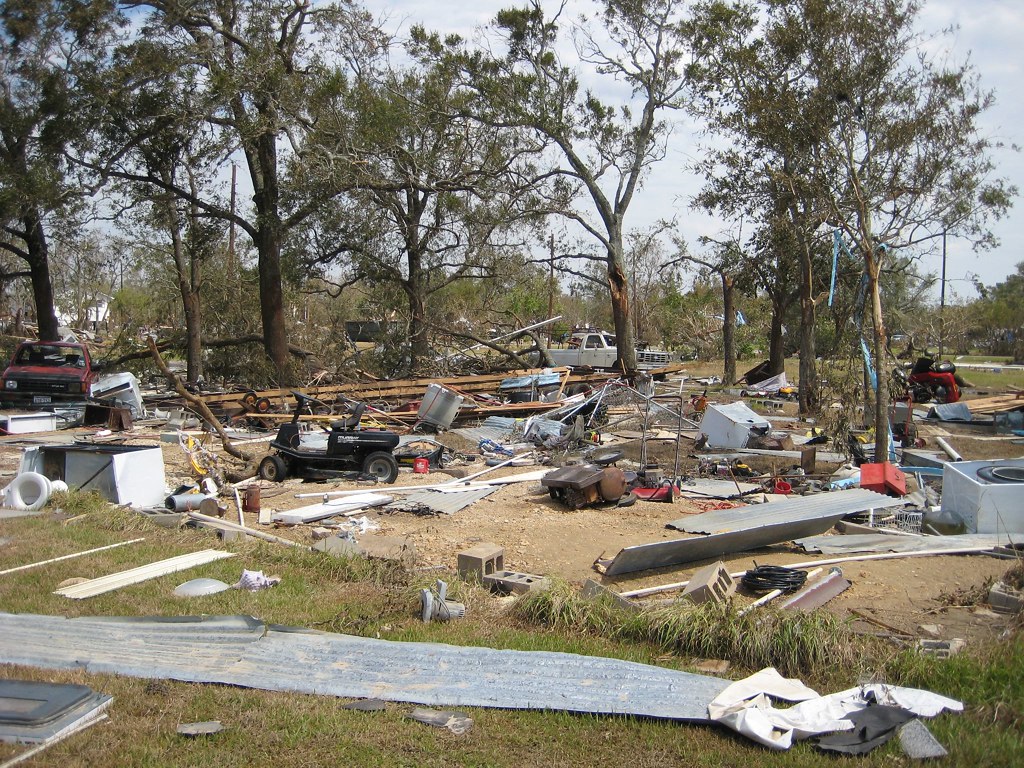
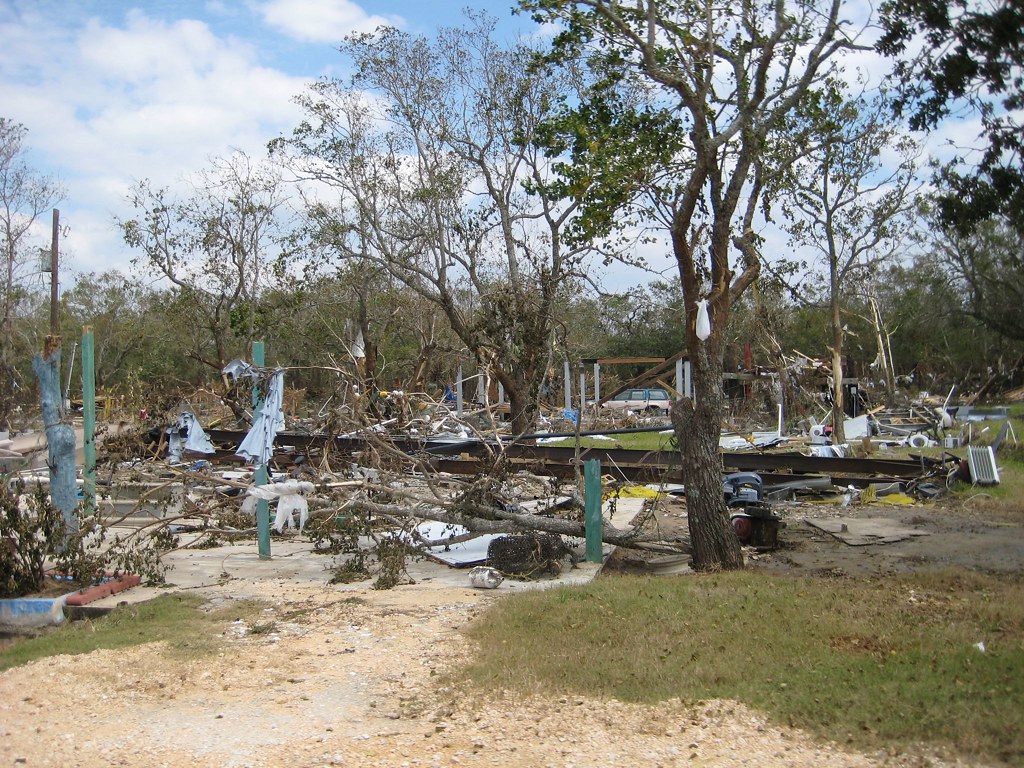

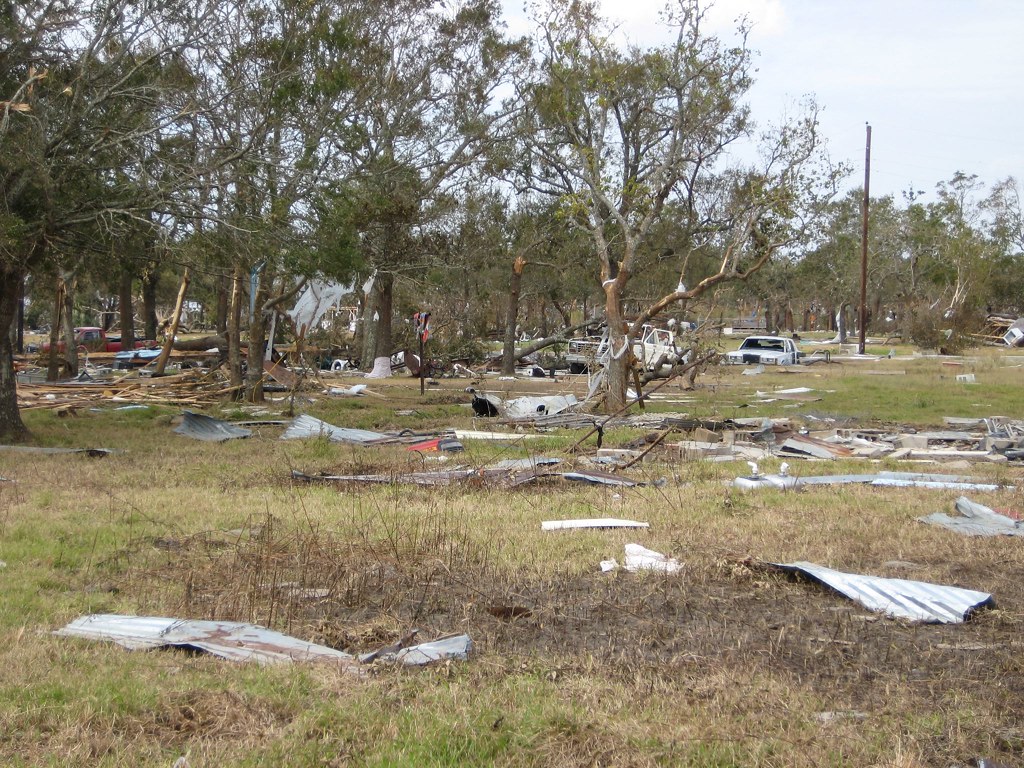 You've heard it before, but Oak Island was one of those places that you see on television and it looks bad, but until you see it in person and smell it, you really have no idea how bad it is. I could make this blog 10 pages long and still not give justice to the power of this storm or what the survivors are still going through to get their lives back in order.
You've heard it before, but Oak Island was one of those places that you see on television and it looks bad, but until you see it in person and smell it, you really have no idea how bad it is. I could make this blog 10 pages long and still not give justice to the power of this storm or what the survivors are still going through to get their lives back in order.
Carolina and I decided to turn a character-based story on several of the survivors in Oak Island. The community is mostly low-income and many of its residents are on some type of government subsidy. They couldn't afford a hotel even if they could find one. Most wouldn't have stayed in a hotel anyway. They didn't want to stay in the temporary shelters that had been set up. Fearing what little they had left would be stolen by looters, many residents slept in their cars and did not venture far from the town. One resident told me about how he reported that he'd chased looters off of his property to an officer patrolling the area. The officer saw a shotgun hanging in the back of this guy's pickup truck and asked if it was really loaded. The resident told the officer it wouldn't do any good if it wasn't. I love Texans.
One of the girl we were interviewing's friends ran to tell her that they'd found her nightstand in a field nearby and its contents were still inside. We decided to make that the focus of our story.
After we finished shooting the story, Kevin Greer called us with his satellite phone (the storm also damaged many cell towers and cell service was really hit and miss). He was still in Anahuac. He'd talked to the county clerk and she told him the story about the guy riding out the storm on a log was true. Kevin got a cell phone number and was able to make contact with the guy and confirm his story. This guy, I'll call him John since I can't remember his name, was a retired postal worker and former marine living on the Bolivar Peninsula. His wife left before the storm, but he decided to ride it out from home. As the surge moved in, he was forced to swim out his window to save his life. He was able to grab onto a telephone pole as the surge pushed him off of the peninsula and out into the bay. He said he was not worried about drowning as much as he was being hit by the flying debris. Somewhere along this journey a child's life vest floated by and he was able to squeeze into it. Later a kayak floated by and he was able to upgrade from his telephone pole to the strap on the kayak. He doesn't remember a whole lot after that, but he was found the following day hanging from a tree. The only injuries he suffered were some cuts and scrapes, and two broken ankles. We had to interview this guy. He told Kevin that he had been taken from Anahuac to Huntsville, Texas about an hour north of Houston.
Carolina and I set off and met Kevin in Anahuac. Back west down I-10 we drove for about 30 minutes when Kevin pulled his truck off the road. He'd called Survivor John back for more specific directions. Survivor John wasn't really in Huntsville, he was closer to Dallas. Kevin would have to go interview him the following day, because we didn't have time to make the drive and we had to get something on the air.
Back to Oak Island.
It didn't take long to put the story together once we got back. Carolina had written it during the ride back. Here is the story we filed:STANDBY="Loading Windows Media Player components..." TYPE="application/x-oleobject">
WIDTH="192" HEIGHT="190" ShowControls="1" ShowStatusBar="0" ShowDisplay="0" autostart="0">
While Kevin was breaking down the live truck for the trip back to Houston, I snapped off a couple more photos from the area.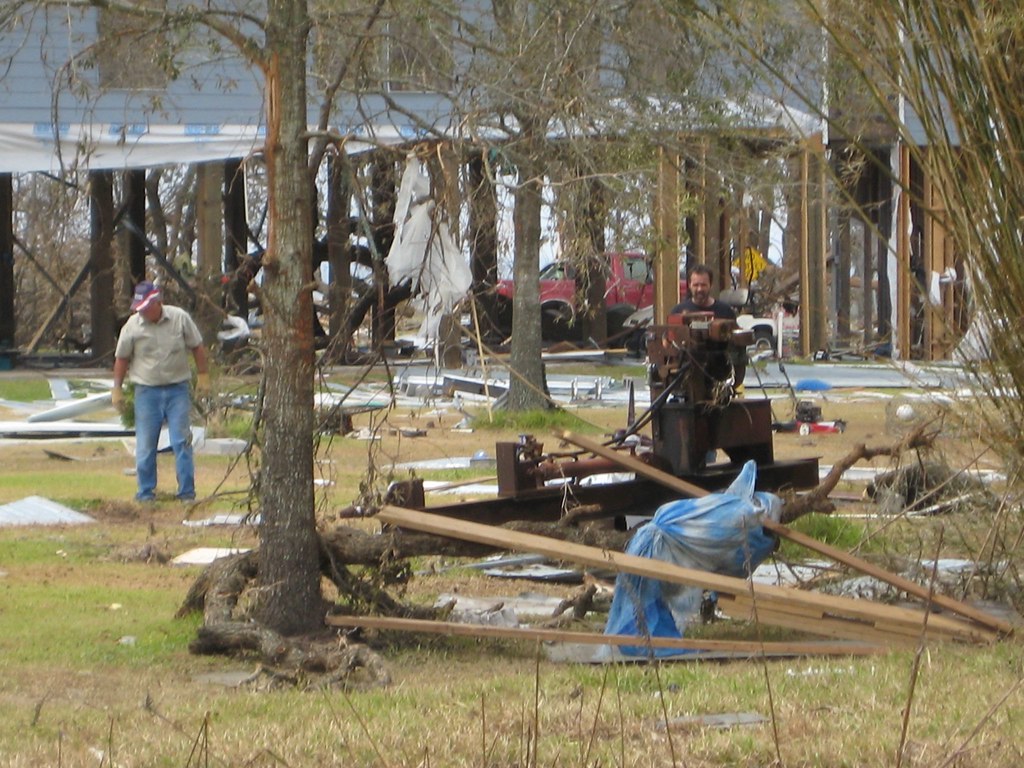

This is one of my favorite photos: It shows the Texan character.
It shows the Texan character.
Here are a few more: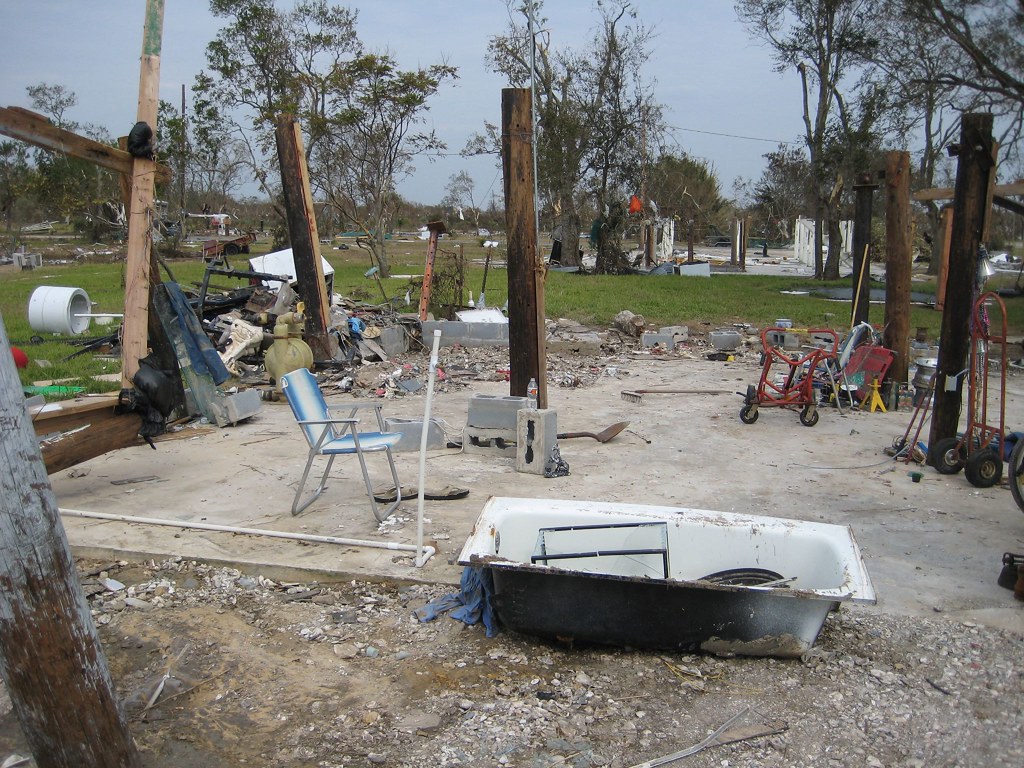

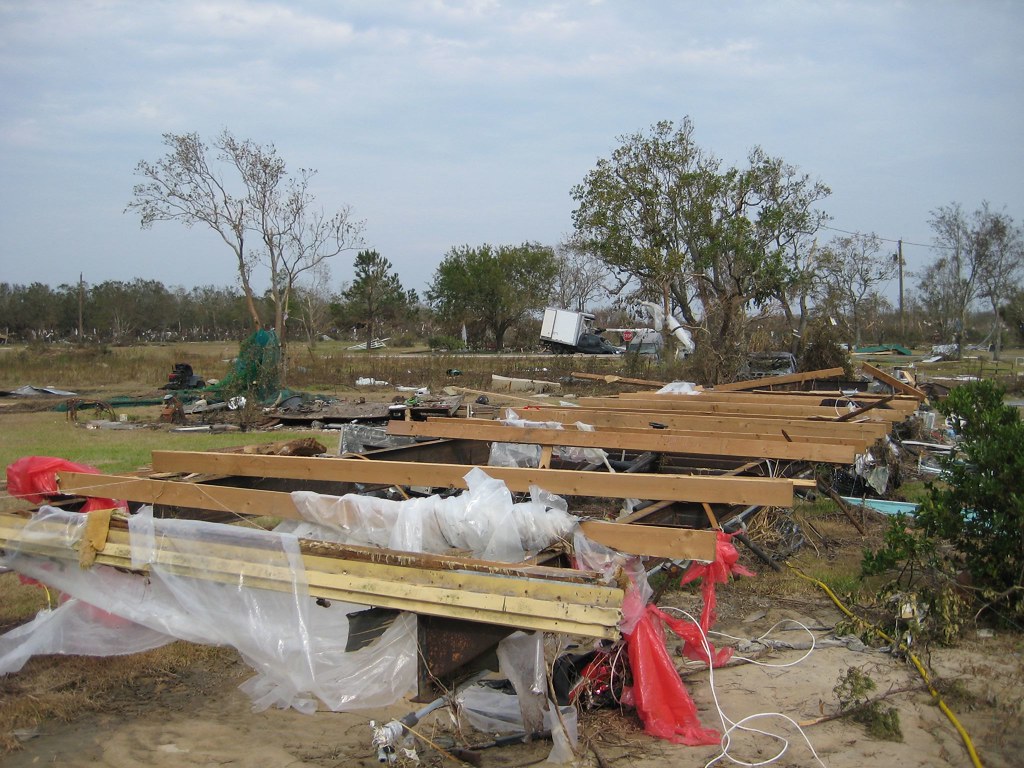
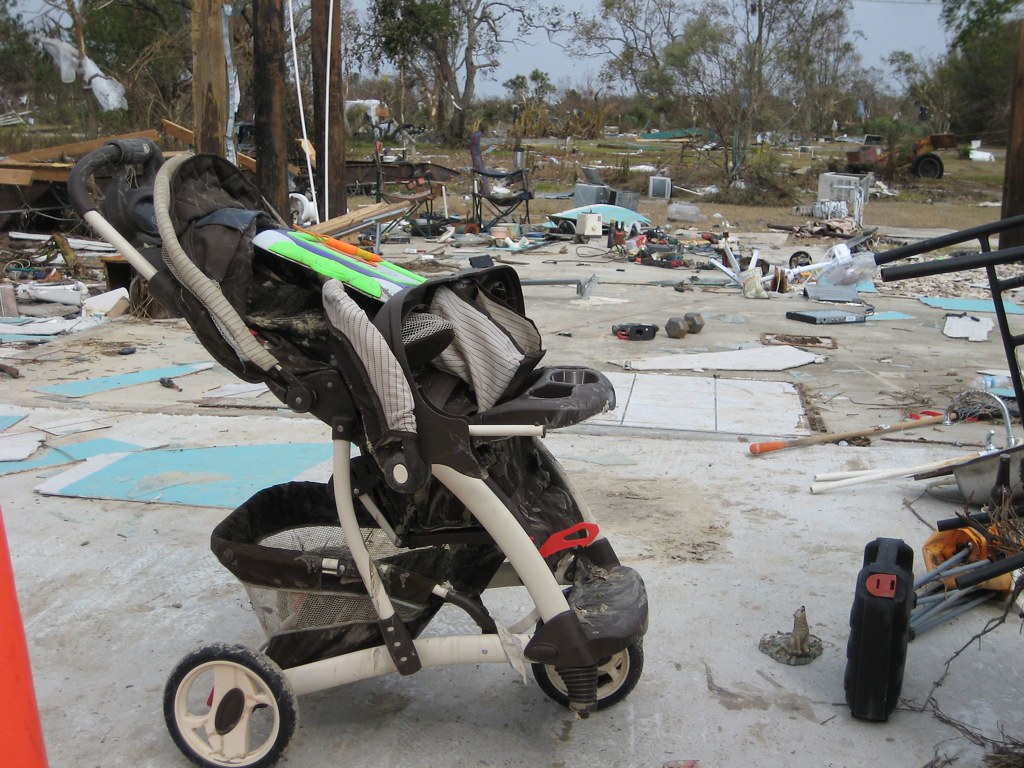
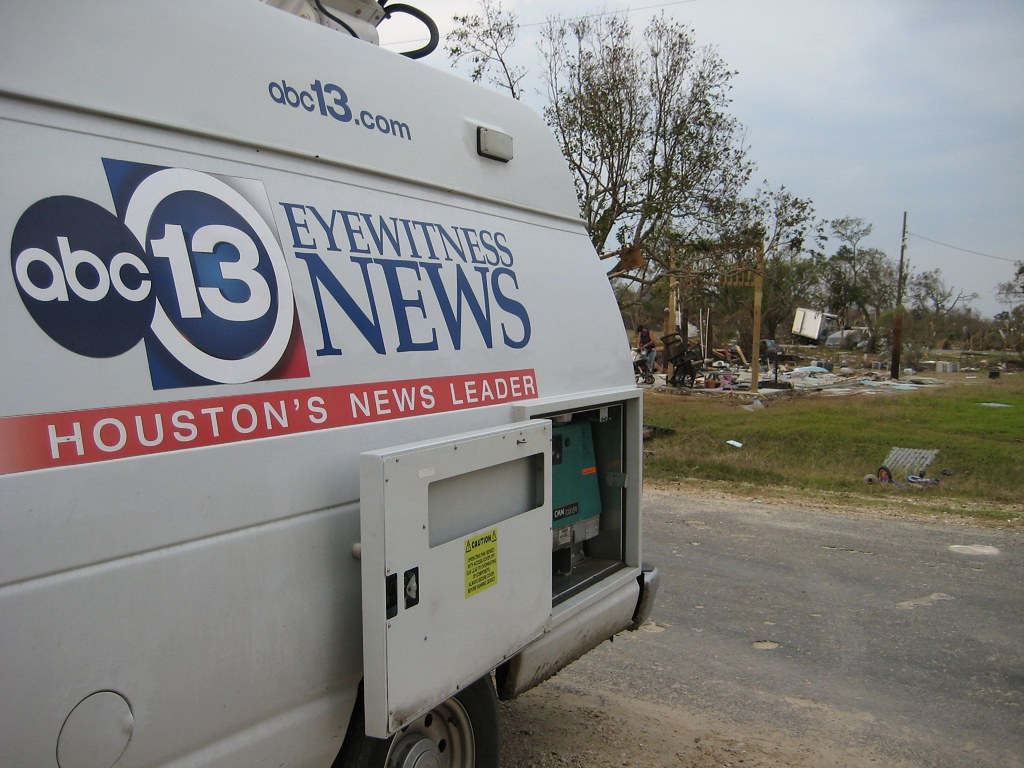
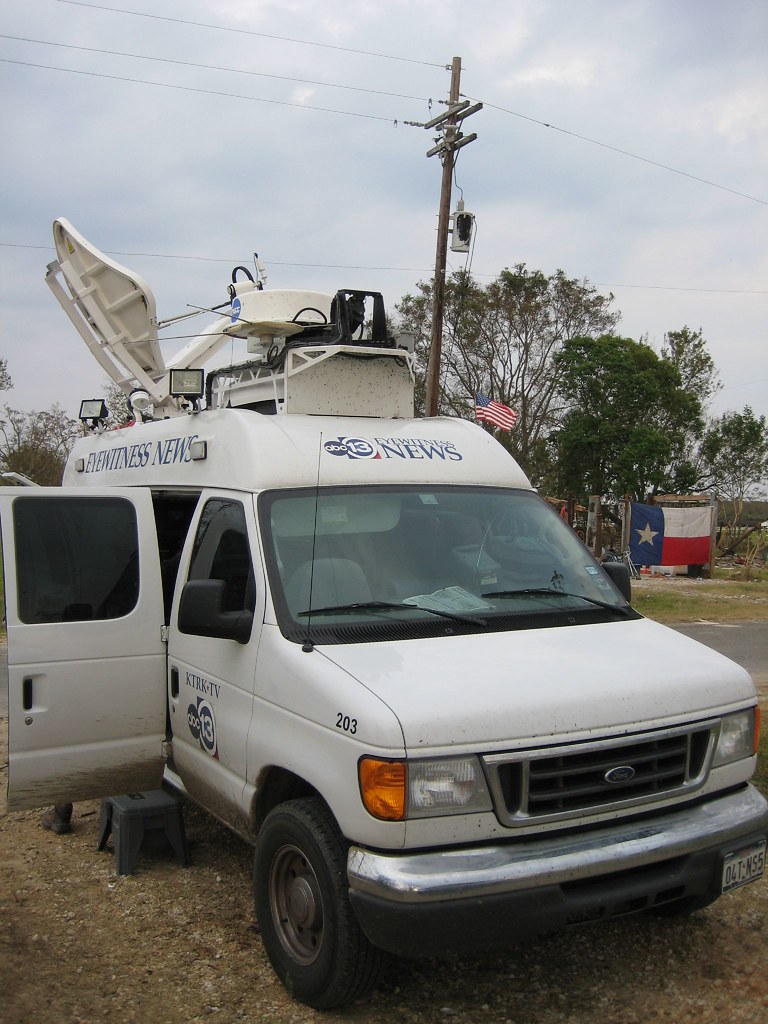
Just before we left the sun began to set on the water. One of the waterfront homes that survived was elevated and located next to where we did our liveshot. The couple that lived there sat under the house watching the sunset. "Isn't this great?," they yelled over to me. With all they've been through, they still took pleasure in something as simple as a sunset. Here are a few of the sunset shots:
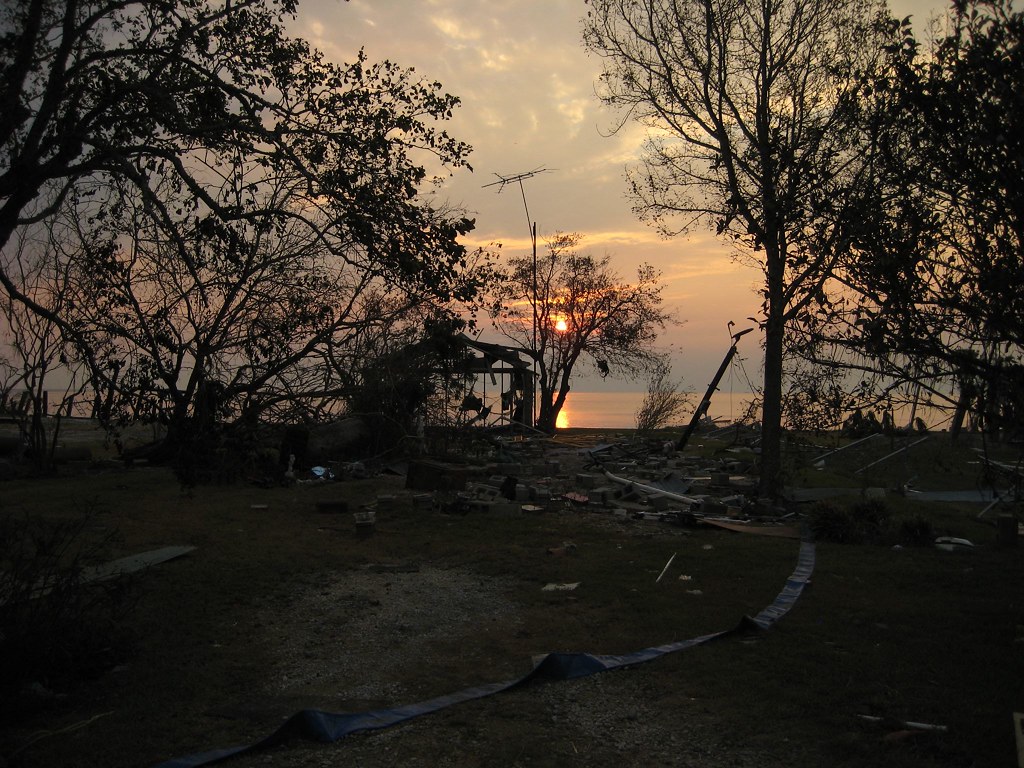
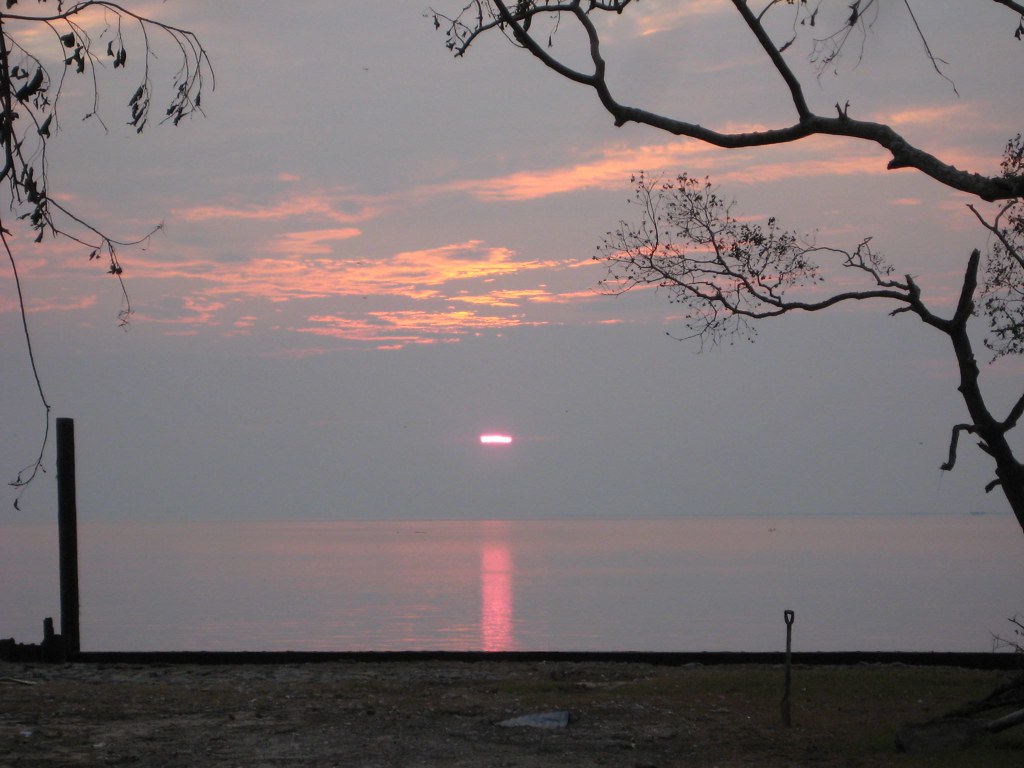


Here's me with WABC reporter Carolina Leid:
The rest of the trip I worked without a reporter. By Friday, September 19, most of the crews from the other ABC O&O's had gone home. I think the Toledo crew was the only one that stayed. Friday things were calming down at the station a little bit. They were still covering the hurricane recovery, but they had resumed normal hours for their newscast times. It was kind of a quiet day from me too. The assignment desk decided that the north Houston suburbs hadn't had much focus and had me head there by myself to talk to some people in some different neighborhoods.
First I hit the Garden Oaks and Oak Forest neighborhoods on the northwest side of Houston. These are established neighborhoods. Middleclass. Most of the houses are 30+ years old. Ike's winds didn't spare them. Being an established neighborhood, many of the trees have reached maturity. On either side of the road there was a debris pile 6 feet high stacked with a combination of brush and huge logs. To make a comparison, this area is similar to the neighborhood surrounding the city of Sylvania's water tower. The difference is about one third of the largest trees had come crashing down. The residents I talked to, though still without power, seemed to be in good spirits. The other thing that suprised me was the number of homes that were able to come out unscathed. Yes, a few were hit, but so many of the big trees fell to the ground, totally missing the property owner's home.
I spent the afternoon gathering video of Houston's public schools. Some suffered damage, some didn't. It was announced that Friday that school would resume the following Monday. KTRK had a reporter at the school's headquarters, but he needed video for his story. After driving all over the city for a several hours, I hopped on I-610 to take him the video. I quickly found that Houston was returning to normal.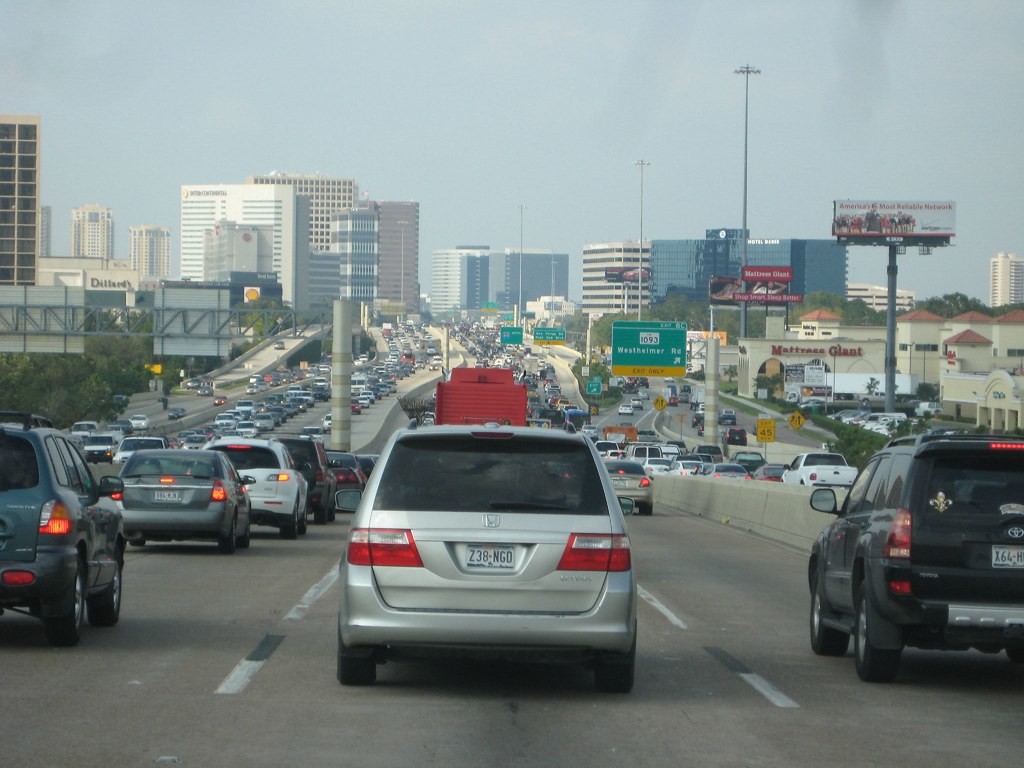

What should have been a 15 minute drive, according to my GPS navigation system, took me nearly 2 1/2 hours because traffic was backed up so bad.
Saturday morning I showed up to work and was sent solo to the small town of Webster. A church there was passing out food and bibles to anyone in need. The church was working with a group called God's Pit Crew. The Virginia-based organization runs a crisis response team to help those in need that travels all over the country. For hours, cars filed in and out of the church parking lot to get what assistance they could. Some of the Pit Crew members even traveled out to people's houses with chainsaws to help cut debris and speed up the recovery process.
Next I headed south down I-45 to League City. The Red Cross had established a base to prepare meals and load their Emergency Response Vehicles (ERV). I got there just as the last of the lunches were being sent out. In this area that must have covered 3 football fields, I was told over 100,000 meals had been prepared since they set up shop.
Next I was sent to a FEMA site that had reportedly shut down. When I got there I found that this was untrue. Somebody had driven by the site and saw the help tent was empty. This person then called KTRK and told them that FEMA was not helping those in need as promised.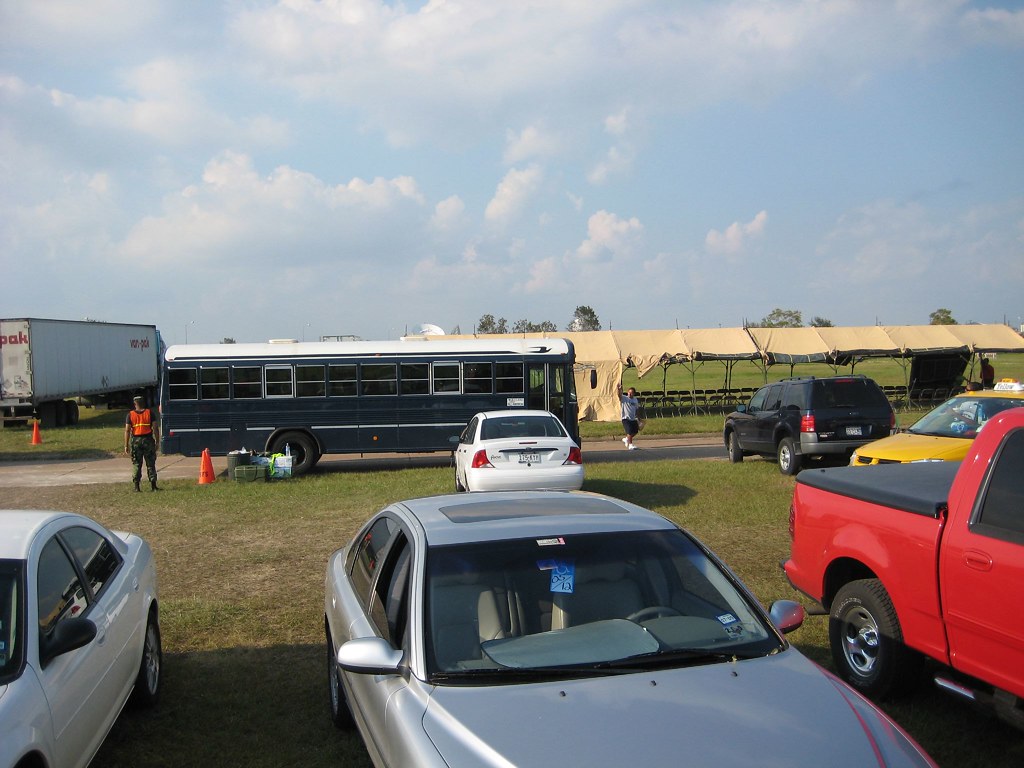
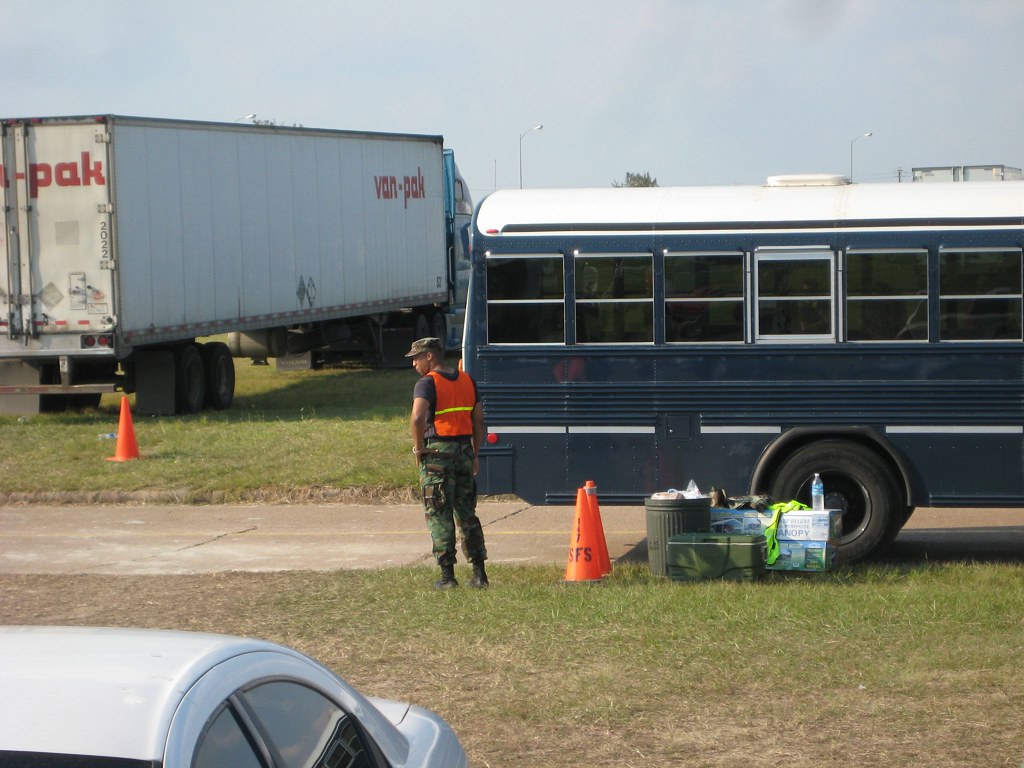 When I got there I found that FEMA representatives were taking initial information in the tent outside. If people met the requirements, they were bussed to an indoor location to complete the paperwork.
When I got there I found that FEMA representatives were taking initial information in the tent outside. If people met the requirements, they were bussed to an indoor location to complete the paperwork.
I also spent some time that Saturday talking to people at the washaterias. What is a washateria? Nothing special, it's what we would call a laundry mat up here. Being without power for over a week now, people had run out of clean clothes and the waits at the washaterias were hours long.
Before I could go home for the day, I was sent out to the Ridgecreek neighborhood to get video of a home. A small family was found dead in their home after running a generator in their garage.
Kevin Beining and I decided we deserved a good meal Saturday night after all we'd done in the previous week.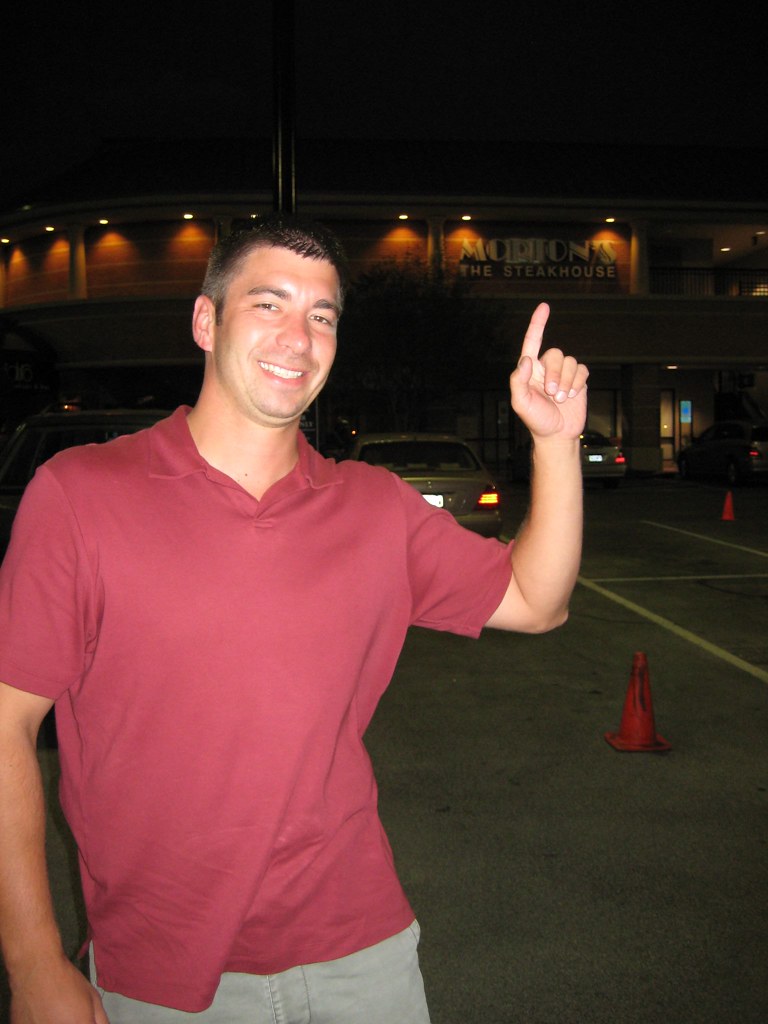
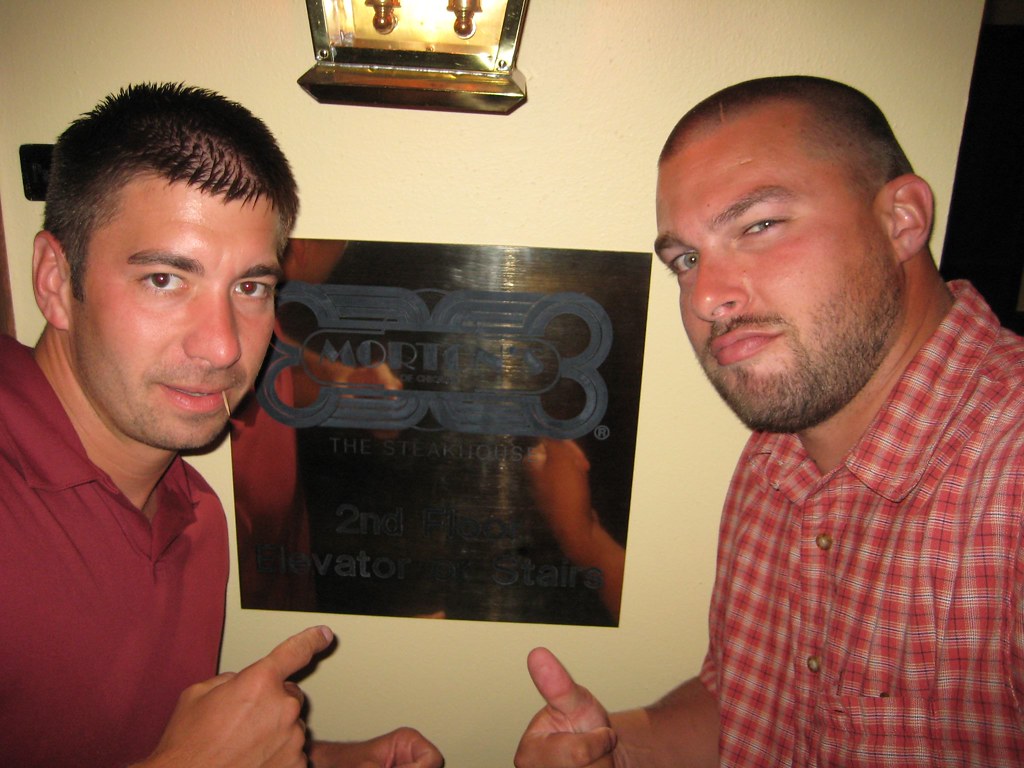
 We went to Morton's Steakhouse and had a couple excellent steaks. I also got to show off my new boots I picked up at Cavender's in Webster.
We went to Morton's Steakhouse and had a couple excellent steaks. I also got to show off my new boots I picked up at Cavender's in Webster.
Sunday, September 21, 2008, our last day. We were ready to head home. But, before we could go home, we all had to go into work that morning. Our flight wasn't scheduled to takeoff until five in the afternoon. I was sent out to Deer Park, a community between Houston and Galveston. The Deer Park Church of Christ had been without power all week and had decided to hold Sunday Service in the parking lot. I talked to the pastor about a half an hour before the service was scheduled to start. He said he didn't expect many people because of the conditions. As the time for the service neared the entire parking was completely filled.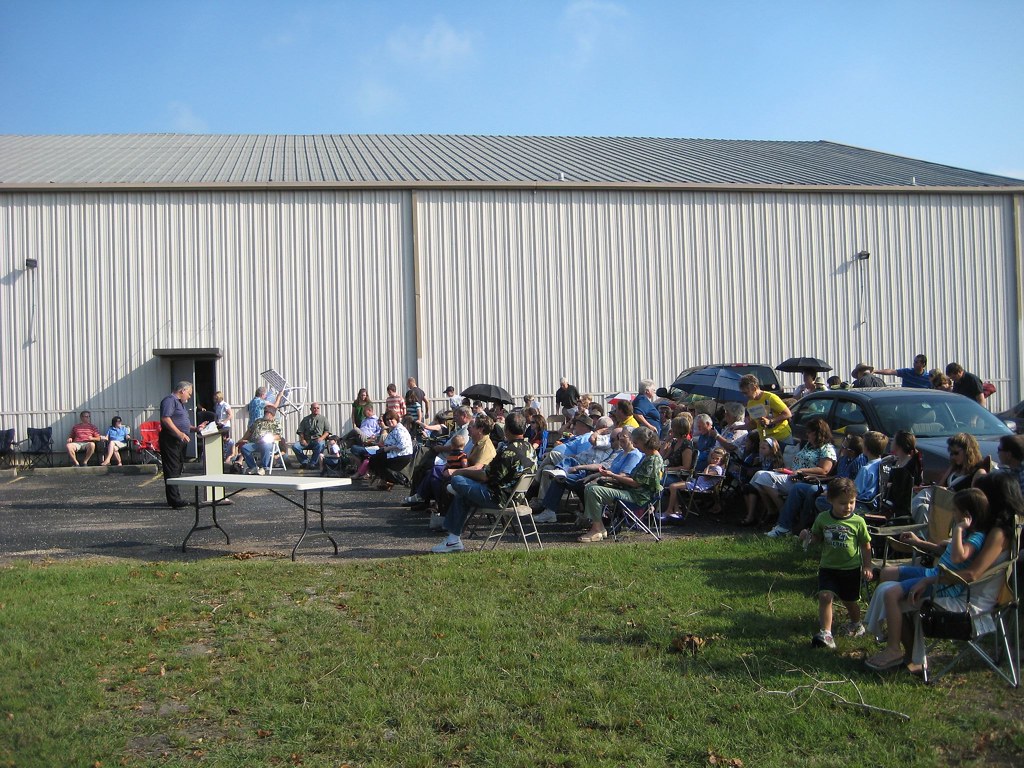
The entire congretation had come out with umbrellas, bug spray, and lawn chairs. It was a pretty cool sight to see. About five minutes before the service was scheduled to begin, power was restored to the church (service was still held outside because it would have taken too long for the air conditioner to cool the building.
I met Jeff Smith, Jason Klocko and Kevin Beining back at KTRK. We checked out of the hotel, but before we headed to the airport, we needed some Texas BBQ.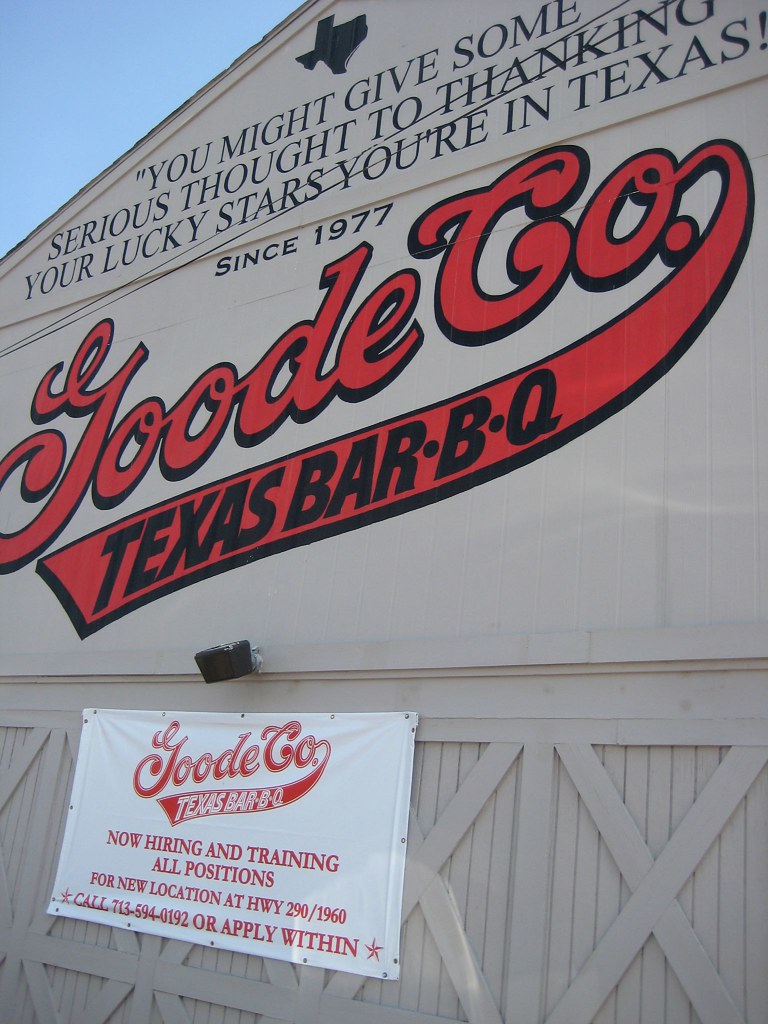


 Kevin and I'd eaten at Goode Company Bar-B-Q when we were down to cover Katrina and Rita. The brisket and pecan pie alone are worth a trip to Texas.
Kevin and I'd eaten at Goode Company Bar-B-Q when we were down to cover Katrina and Rita. The brisket and pecan pie alone are worth a trip to Texas.
It will take Texans some time to completely recover from Hurricane Ike. Even as I finish writing this post on October 13, 2008, there are still about 10,000 homes without power in the areas hit hardest by hurricane Ike. I'm glad we made the trip to help cover this hurricane. We tried our best to give our viewers and readers an accurate description of the storm's power. Covering a story like this shows us the very worst of mother nature, but it can also show us the very best of the human spirit. Every day we as journalists spend an entire day working on a story, and only share two minutes at the end of the day with our viewers. I hope these last two posts were able to give you just a little bit of an insight as to what we see when we're covering something like this from the field.
-Billau
The day before our live truck operator, Kevin Greer, had struck up a conversation with one of the Chambers County locals who told him some of the stories of survival that she'd heard. Apparently the Chambers County clerk had interviewed a survivor who tried to ride out the storm in his home on the Bolivar Peninsula. As his home flooded, he swam out the window and floated across the bay hanging onto a tree trunk that was floating in the surge. Kevin was heading with his camera and live truck to Anahuac Hospital to try to find this guy. Carolina and I were going to try to find Uncle Donny again.
We traveled the same path as we did the day before. We stopped at Donny's brother's house again, but they had no idea where he was. Rather than spend the day searching for Uncle Donny, Carolina and I headed to Oak Island, just down the road from Double Bayou. Kevin Greer driven through Oak Island the previous day and told us it looked like an atomic bomb had been dropped into the center of this small, waterfront community. When we arrived we saw that Kevin's description was not an overstatement.
The closer we got to the water, the less houses looked like houses and more like debris fields. The field to our left on the way into the community had a roof and countless pieces of clothing.
 Another house had its roof smashed down onto and into the first floor. At the edge of town the a brush line was so thick full of all kinds of debris, the vegetation was no longer visible. Then we saw what was left of the neighborhood. Slabs where houses or trailers once stood were bare. Front porch steps led up to nothing. It reminded me of the devastation on the Mississippi coast after Katrina. Hurricane Ike's winds and surge came rolling in and nothing man-made was going to stop it.
Another house had its roof smashed down onto and into the first floor. At the edge of town the a brush line was so thick full of all kinds of debris, the vegetation was no longer visible. Then we saw what was left of the neighborhood. Slabs where houses or trailers once stood were bare. Front porch steps led up to nothing. It reminded me of the devastation on the Mississippi coast after Katrina. Hurricane Ike's winds and surge came rolling in and nothing man-made was going to stop it.We were told by some of the residents that there were nearly 350 homes in the community. Looking around I only saw a handful, maybe half a dozen still standing, none unscathed.




 You've heard it before, but Oak Island was one of those places that you see on television and it looks bad, but until you see it in person and smell it, you really have no idea how bad it is. I could make this blog 10 pages long and still not give justice to the power of this storm or what the survivors are still going through to get their lives back in order.
You've heard it before, but Oak Island was one of those places that you see on television and it looks bad, but until you see it in person and smell it, you really have no idea how bad it is. I could make this blog 10 pages long and still not give justice to the power of this storm or what the survivors are still going through to get their lives back in order.Carolina and I decided to turn a character-based story on several of the survivors in Oak Island. The community is mostly low-income and many of its residents are on some type of government subsidy. They couldn't afford a hotel even if they could find one. Most wouldn't have stayed in a hotel anyway. They didn't want to stay in the temporary shelters that had been set up. Fearing what little they had left would be stolen by looters, many residents slept in their cars and did not venture far from the town. One resident told me about how he reported that he'd chased looters off of his property to an officer patrolling the area. The officer saw a shotgun hanging in the back of this guy's pickup truck and asked if it was really loaded. The resident told the officer it wouldn't do any good if it wasn't. I love Texans.
One of the girl we were interviewing's friends ran to tell her that they'd found her nightstand in a field nearby and its contents were still inside. We decided to make that the focus of our story.
After we finished shooting the story, Kevin Greer called us with his satellite phone (the storm also damaged many cell towers and cell service was really hit and miss). He was still in Anahuac. He'd talked to the county clerk and she told him the story about the guy riding out the storm on a log was true. Kevin got a cell phone number and was able to make contact with the guy and confirm his story. This guy, I'll call him John since I can't remember his name, was a retired postal worker and former marine living on the Bolivar Peninsula. His wife left before the storm, but he decided to ride it out from home. As the surge moved in, he was forced to swim out his window to save his life. He was able to grab onto a telephone pole as the surge pushed him off of the peninsula and out into the bay. He said he was not worried about drowning as much as he was being hit by the flying debris. Somewhere along this journey a child's life vest floated by and he was able to squeeze into it. Later a kayak floated by and he was able to upgrade from his telephone pole to the strap on the kayak. He doesn't remember a whole lot after that, but he was found the following day hanging from a tree. The only injuries he suffered were some cuts and scrapes, and two broken ankles. We had to interview this guy. He told Kevin that he had been taken from Anahuac to Huntsville, Texas about an hour north of Houston.
Carolina and I set off and met Kevin in Anahuac. Back west down I-10 we drove for about 30 minutes when Kevin pulled his truck off the road. He'd called Survivor John back for more specific directions. Survivor John wasn't really in Huntsville, he was closer to Dallas. Kevin would have to go interview him the following day, because we didn't have time to make the drive and we had to get something on the air.
Back to Oak Island.
It didn't take long to put the story together once we got back. Carolina had written it during the ride back. Here is the story we filed:STANDBY="Loading Windows Media Player components..." TYPE="application/x-oleobject">
WIDTH="192" HEIGHT="190" ShowControls="1" ShowStatusBar="0" ShowDisplay="0" autostart="0">
While Kevin was breaking down the live truck for the trip back to Houston, I snapped off a couple more photos from the area.


This is one of my favorite photos:
 It shows the Texan character.
It shows the Texan character.Here are a few more:






Just before we left the sun began to set on the water. One of the waterfront homes that survived was elevated and located next to where we did our liveshot. The couple that lived there sat under the house watching the sunset. "Isn't this great?," they yelled over to me. With all they've been through, they still took pleasure in something as simple as a sunset. Here are a few of the sunset shots:





Here's me with WABC reporter Carolina Leid:

The rest of the trip I worked without a reporter. By Friday, September 19, most of the crews from the other ABC O&O's had gone home. I think the Toledo crew was the only one that stayed. Friday things were calming down at the station a little bit. They were still covering the hurricane recovery, but they had resumed normal hours for their newscast times. It was kind of a quiet day from me too. The assignment desk decided that the north Houston suburbs hadn't had much focus and had me head there by myself to talk to some people in some different neighborhoods.
First I hit the Garden Oaks and Oak Forest neighborhoods on the northwest side of Houston. These are established neighborhoods. Middleclass. Most of the houses are 30+ years old. Ike's winds didn't spare them. Being an established neighborhood, many of the trees have reached maturity. On either side of the road there was a debris pile 6 feet high stacked with a combination of brush and huge logs. To make a comparison, this area is similar to the neighborhood surrounding the city of Sylvania's water tower. The difference is about one third of the largest trees had come crashing down. The residents I talked to, though still without power, seemed to be in good spirits. The other thing that suprised me was the number of homes that were able to come out unscathed. Yes, a few were hit, but so many of the big trees fell to the ground, totally missing the property owner's home.
I spent the afternoon gathering video of Houston's public schools. Some suffered damage, some didn't. It was announced that Friday that school would resume the following Monday. KTRK had a reporter at the school's headquarters, but he needed video for his story. After driving all over the city for a several hours, I hopped on I-610 to take him the video. I quickly found that Houston was returning to normal.


What should have been a 15 minute drive, according to my GPS navigation system, took me nearly 2 1/2 hours because traffic was backed up so bad.
Saturday morning I showed up to work and was sent solo to the small town of Webster. A church there was passing out food and bibles to anyone in need. The church was working with a group called God's Pit Crew. The Virginia-based organization runs a crisis response team to help those in need that travels all over the country. For hours, cars filed in and out of the church parking lot to get what assistance they could. Some of the Pit Crew members even traveled out to people's houses with chainsaws to help cut debris and speed up the recovery process.
Next I headed south down I-45 to League City. The Red Cross had established a base to prepare meals and load their Emergency Response Vehicles (ERV). I got there just as the last of the lunches were being sent out. In this area that must have covered 3 football fields, I was told over 100,000 meals had been prepared since they set up shop.
Next I was sent to a FEMA site that had reportedly shut down. When I got there I found that this was untrue. Somebody had driven by the site and saw the help tent was empty. This person then called KTRK and told them that FEMA was not helping those in need as promised.

 When I got there I found that FEMA representatives were taking initial information in the tent outside. If people met the requirements, they were bussed to an indoor location to complete the paperwork.
When I got there I found that FEMA representatives were taking initial information in the tent outside. If people met the requirements, they were bussed to an indoor location to complete the paperwork.I also spent some time that Saturday talking to people at the washaterias. What is a washateria? Nothing special, it's what we would call a laundry mat up here. Being without power for over a week now, people had run out of clean clothes and the waits at the washaterias were hours long.
Before I could go home for the day, I was sent out to the Ridgecreek neighborhood to get video of a home. A small family was found dead in their home after running a generator in their garage.
Kevin Beining and I decided we deserved a good meal Saturday night after all we'd done in the previous week.


 We went to Morton's Steakhouse and had a couple excellent steaks. I also got to show off my new boots I picked up at Cavender's in Webster.
We went to Morton's Steakhouse and had a couple excellent steaks. I also got to show off my new boots I picked up at Cavender's in Webster.Sunday, September 21, 2008, our last day. We were ready to head home. But, before we could go home, we all had to go into work that morning. Our flight wasn't scheduled to takeoff until five in the afternoon. I was sent out to Deer Park, a community between Houston and Galveston. The Deer Park Church of Christ had been without power all week and had decided to hold Sunday Service in the parking lot. I talked to the pastor about a half an hour before the service was scheduled to start. He said he didn't expect many people because of the conditions. As the time for the service neared the entire parking was completely filled.

The entire congretation had come out with umbrellas, bug spray, and lawn chairs. It was a pretty cool sight to see. About five minutes before the service was scheduled to begin, power was restored to the church (service was still held outside because it would have taken too long for the air conditioner to cool the building.
I met Jeff Smith, Jason Klocko and Kevin Beining back at KTRK. We checked out of the hotel, but before we headed to the airport, we needed some Texas BBQ.



 Kevin and I'd eaten at Goode Company Bar-B-Q when we were down to cover Katrina and Rita. The brisket and pecan pie alone are worth a trip to Texas.
Kevin and I'd eaten at Goode Company Bar-B-Q when we were down to cover Katrina and Rita. The brisket and pecan pie alone are worth a trip to Texas.It will take Texans some time to completely recover from Hurricane Ike. Even as I finish writing this post on October 13, 2008, there are still about 10,000 homes without power in the areas hit hardest by hurricane Ike. I'm glad we made the trip to help cover this hurricane. We tried our best to give our viewers and readers an accurate description of the storm's power. Covering a story like this shows us the very worst of mother nature, but it can also show us the very best of the human spirit. Every day we as journalists spend an entire day working on a story, and only share two minutes at the end of the day with our viewers. I hope these last two posts were able to give you just a little bit of an insight as to what we see when we're covering something like this from the field.
-Billau
Friday, September 26, 2008
Hurricane Ike - Through My Eyes Vol. I
I spent a week working for our sister station KTRK ABC13 recently. Crews from all of the ABC O&O stations except Philidelphia headed south to help with coverage of Hurricane Ike. The destruction down there was incredible. What reminded me of going down there in 2005 to cover Katrina and Rita, is how much more real the damage is when you see it in person. We can become desensitized from the images on our televisions because they all seem to look the same. When you see a whole waterfront neighborhood where a community once stood and all that is left are the posts that the houses once stood on, it quickly becomes very real. I spent much of my time in the communities on the east side of Galveston Bay. In one location, there was a row of houses that were once right on the gulf. Today it's difficult to tell there were ever houses there. Everything, everything blew across the bay. Driving through a marshland we started to see roofs, walls, and refrigerators. No driveways. There never were houses in this area. Not even within 10 miles or more. That was the power of this storm.
Kevin and I flew into Houston Monday night. We checked into the station around 10:30 central time. After saying hello to a couple of people we remembered from the last trip, we checked our schedules for the next day and checked into our hotel.
Tuesday morning I arrived at KTRK at 8 am.
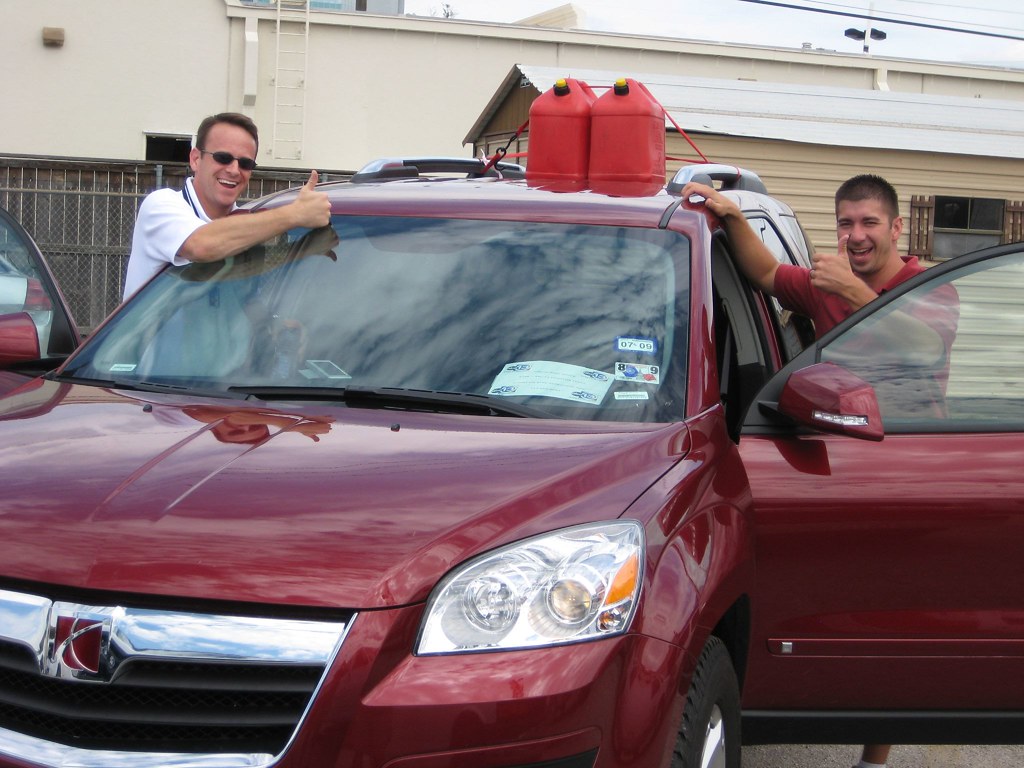 Kevin and Jeff would be working together all week. I was not assigned a reporter. My first task was to go downtown to the Morgan Chase Tower to check the progress of the cleanup in the area. The building is the tallest in the city and a number of its windows were knocked out during the hurricane. There was still very little power in the city, with most of the traffic lights being out they were now four-way stops. Adding to the difficulty were the police roadblocks. Entire city blocks were shut down so that heavy machinery could come in and clear the glass and debris. I talked to a bartender who was back to work for the first time since the storm. A lifelong Houstonian, he'd never seen the city try to recover from something like this.
Kevin and Jeff would be working together all week. I was not assigned a reporter. My first task was to go downtown to the Morgan Chase Tower to check the progress of the cleanup in the area. The building is the tallest in the city and a number of its windows were knocked out during the hurricane. There was still very little power in the city, with most of the traffic lights being out they were now four-way stops. Adding to the difficulty were the police roadblocks. Entire city blocks were shut down so that heavy machinery could come in and clear the glass and debris. I talked to a bartender who was back to work for the first time since the storm. A lifelong Houstonian, he'd never seen the city try to recover from something like this.
My next job for the station was chauffeur. KTRK had stationed a crew out on the Bolivar Peninsula, an area that took a direct hit from Ike. My job was to run a satellite truck operator out to the live location to relieve the operator who'd been stationed there for 48 hours. My new GPS told me the trip from Houston to the peninsula would take about an hour and a half. We left a twelve-thirty. We pulled up to the satellite truck about three-forty five. What I saw on that ride was incredible. As we headed east out I-10, we started to see the full force of this hurricane. Part of I-10 is lies very close to sea level.
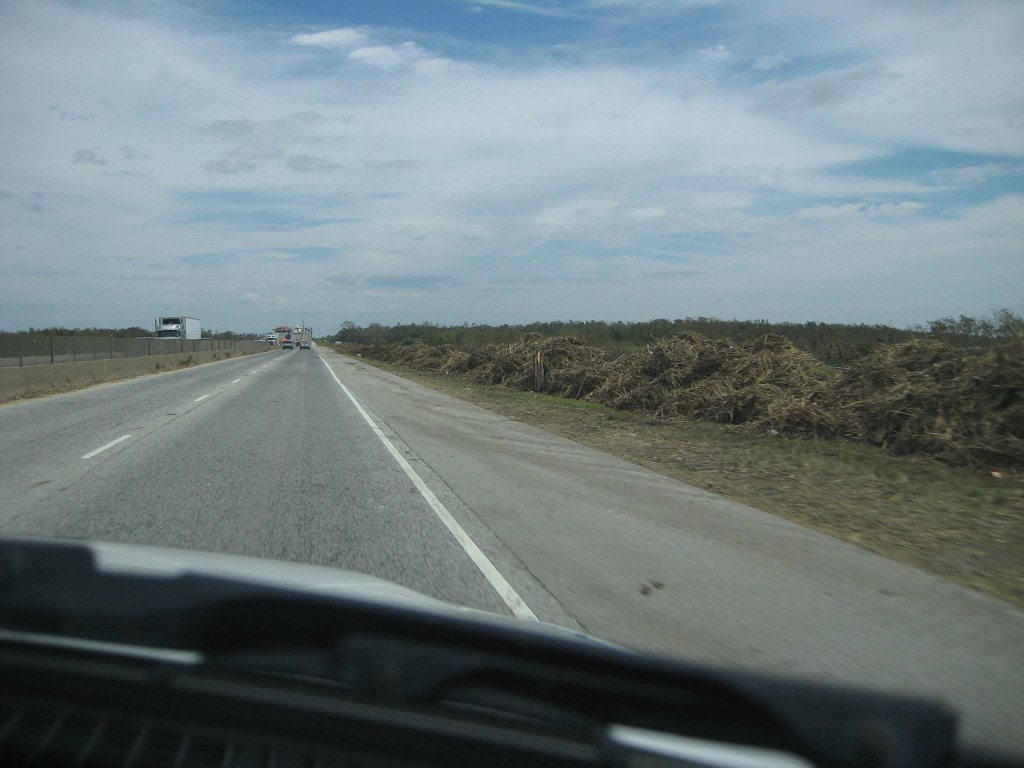 Officials had to use plow trucks to remove the debris the storm surge washed onto the highway. For a 2 mile stretch, there was a 6 foot pile of debris lined up just off the shoulder. Billboards were skeletons with the tattered banners blowing in the wind. It was difficult to know where exits were because the signs were blown off the posts.
Officials had to use plow trucks to remove the debris the storm surge washed onto the highway. For a 2 mile stretch, there was a 6 foot pile of debris lined up just off the shoulder. Billboards were skeletons with the tattered banners blowing in the wind. It was difficult to know where exits were because the signs were blown off the posts.
We stopped to get toilet paper and paper towels at the one open gas station we passed along the way.
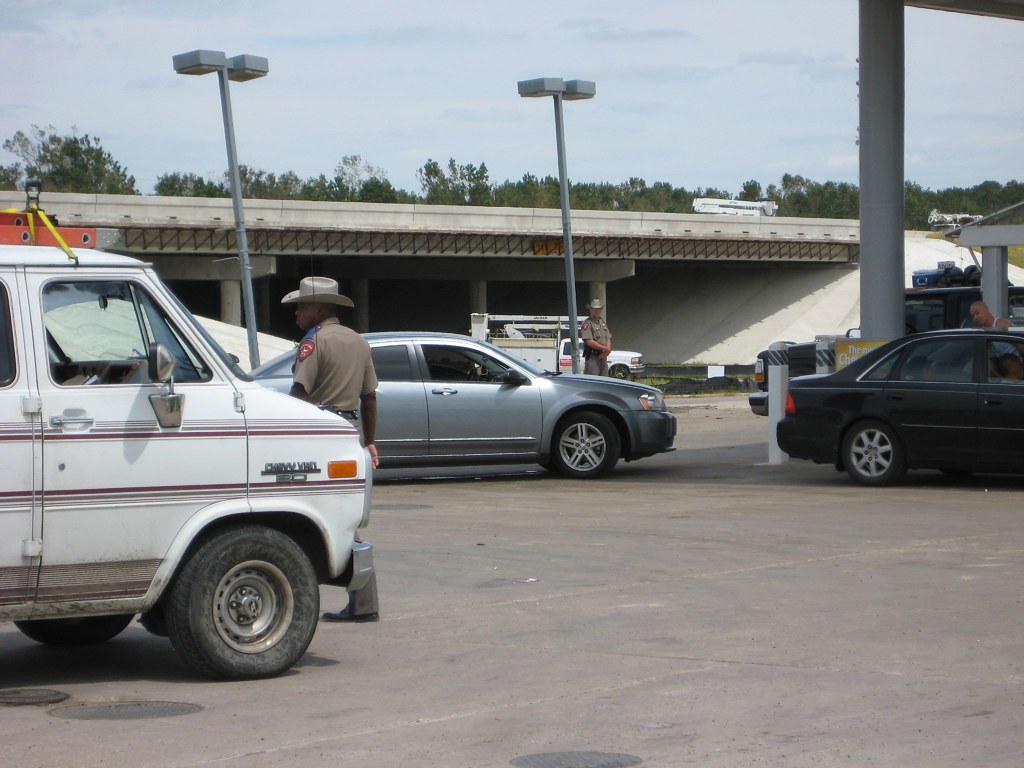 Several state troopers were directing traffic to the pumps and the line was hundreds of yards long.
Several state troopers were directing traffic to the pumps and the line was hundreds of yards long.
Next to the gas station there used to be a farm stand that sold vegetables.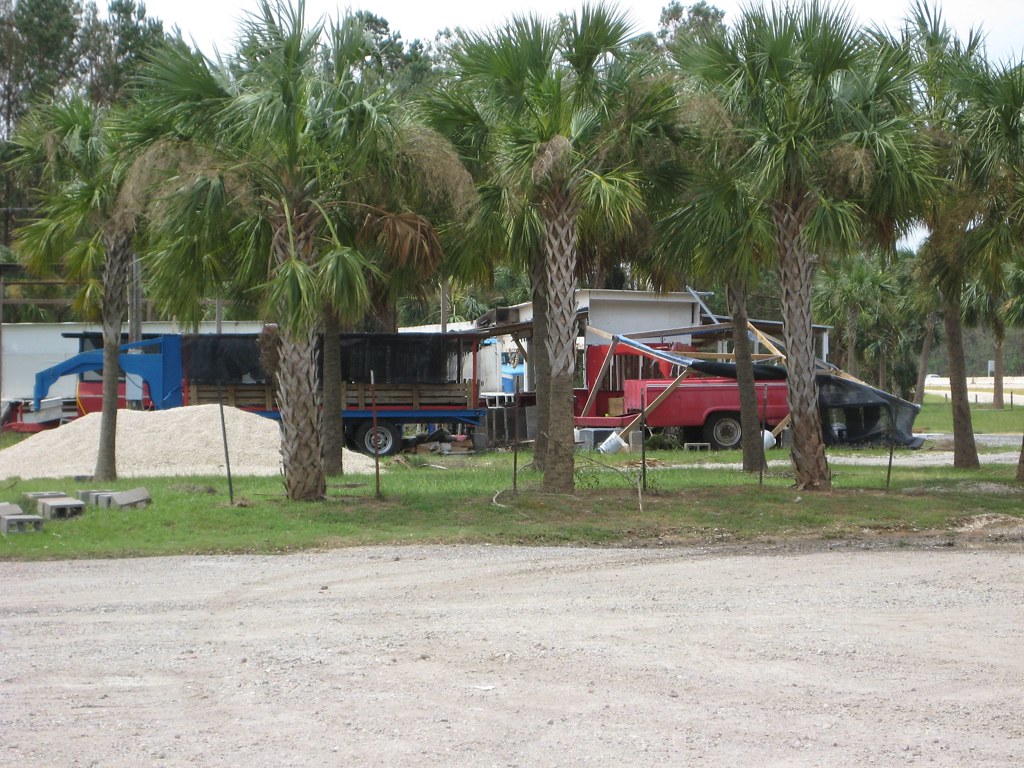
 Ike's winds damaged the stand pretty badly.
Ike's winds damaged the stand pretty badly.
When we got to Route 61 we headed south, and that's where I started to realize the force that this hurricane had. Heading down HWY 61 was like driving through another world. I can't tell you how many times we drove over power lines that were strewn across the road, I quit counting at 25. Trees, huge trees were either snapped in half of ripped right from the ground in which they stood.

 We passed countless boom trucks that power companies from all over the country had dispatched to help with the recovery. Rarely did we see a telephone pole that was not leaning, on its side or snapped in half by Ike's winds. At a police checkpoint, a Texas state trooper needed to see identification for us to travel through. Last he'd heard, the road we'd planned to travel was under water, but we could continue at our own risk. After the checkpoint, our journey took us through a marshy, pasture mix of Chambers County.
We passed countless boom trucks that power companies from all over the country had dispatched to help with the recovery. Rarely did we see a telephone pole that was not leaning, on its side or snapped in half by Ike's winds. At a police checkpoint, a Texas state trooper needed to see identification for us to travel through. Last he'd heard, the road we'd planned to travel was under water, but we could continue at our own risk. After the checkpoint, our journey took us through a marshy, pasture mix of Chambers County.  Metal silos stood like crushed soda cans, a testament to the force of Ike's winds. At one point we passed what used to be a farm. The house and barns were no longer there.
Metal silos stood like crushed soda cans, a testament to the force of Ike's winds. At one point we passed what used to be a farm. The house and barns were no longer there. 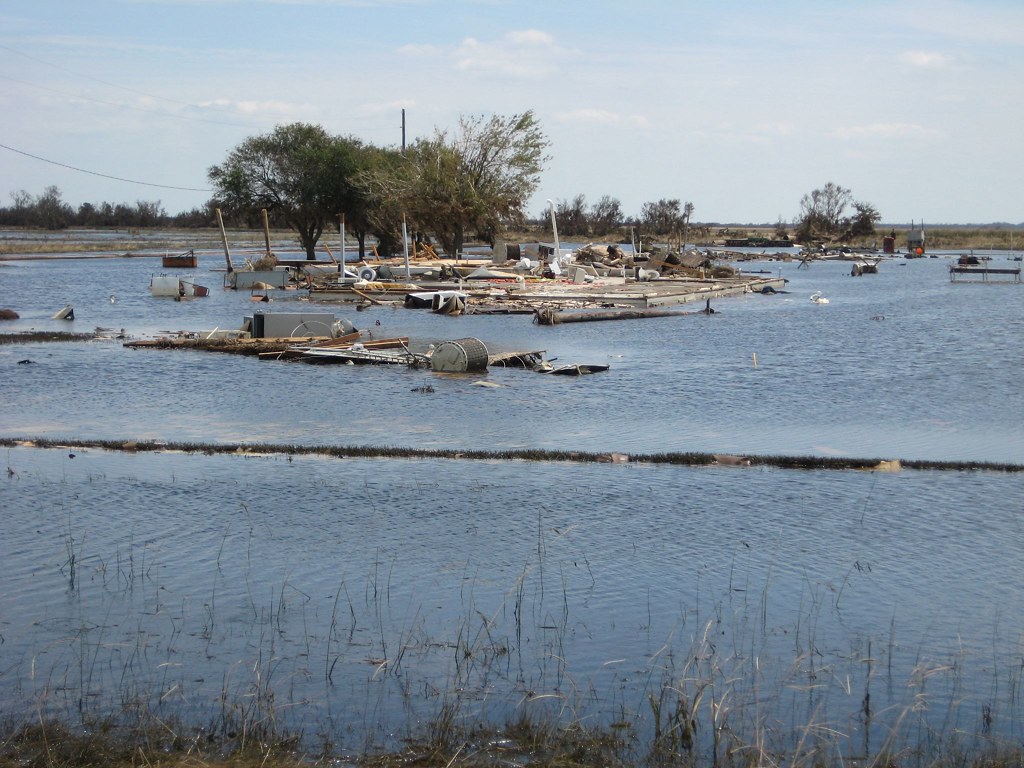
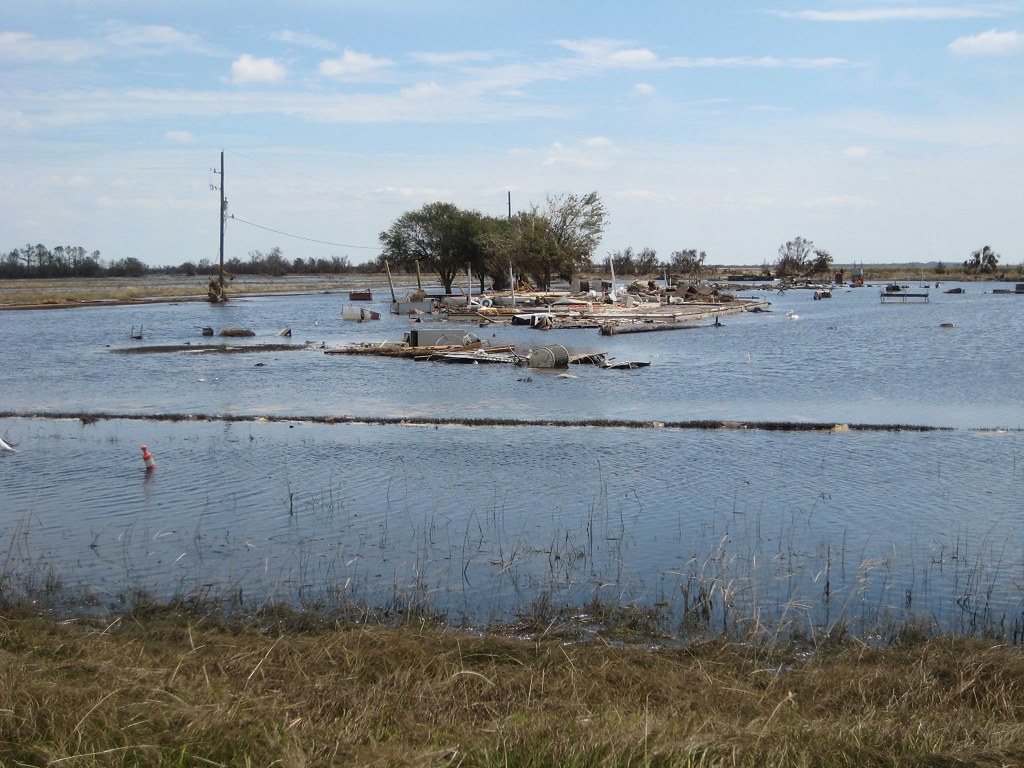
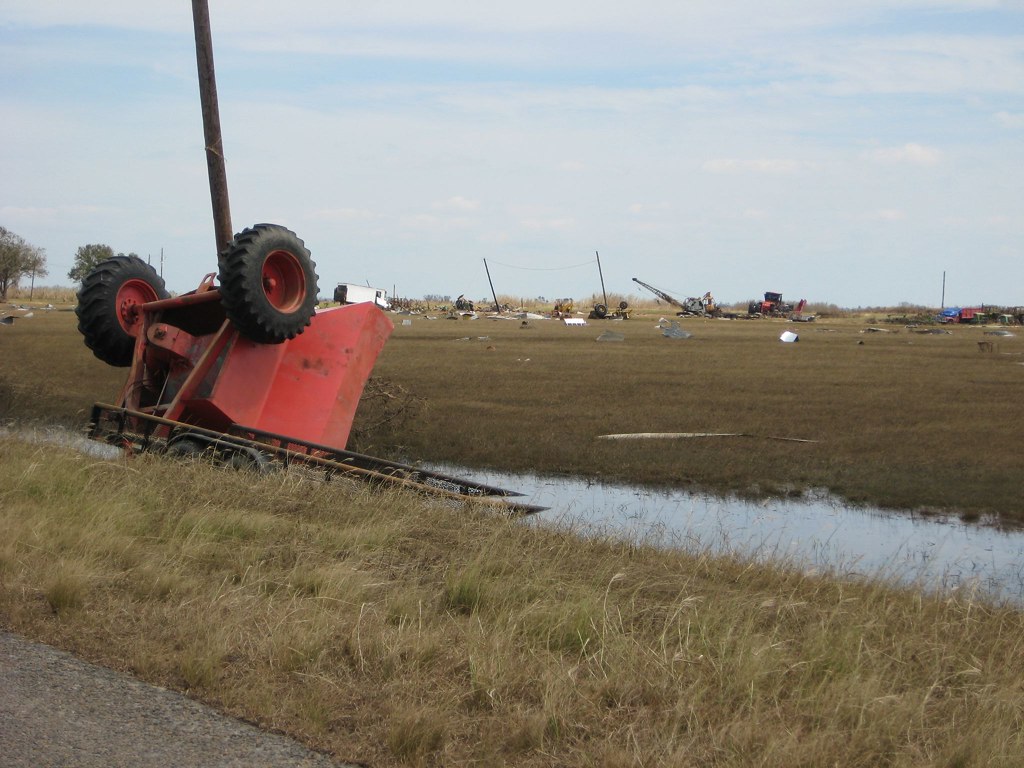
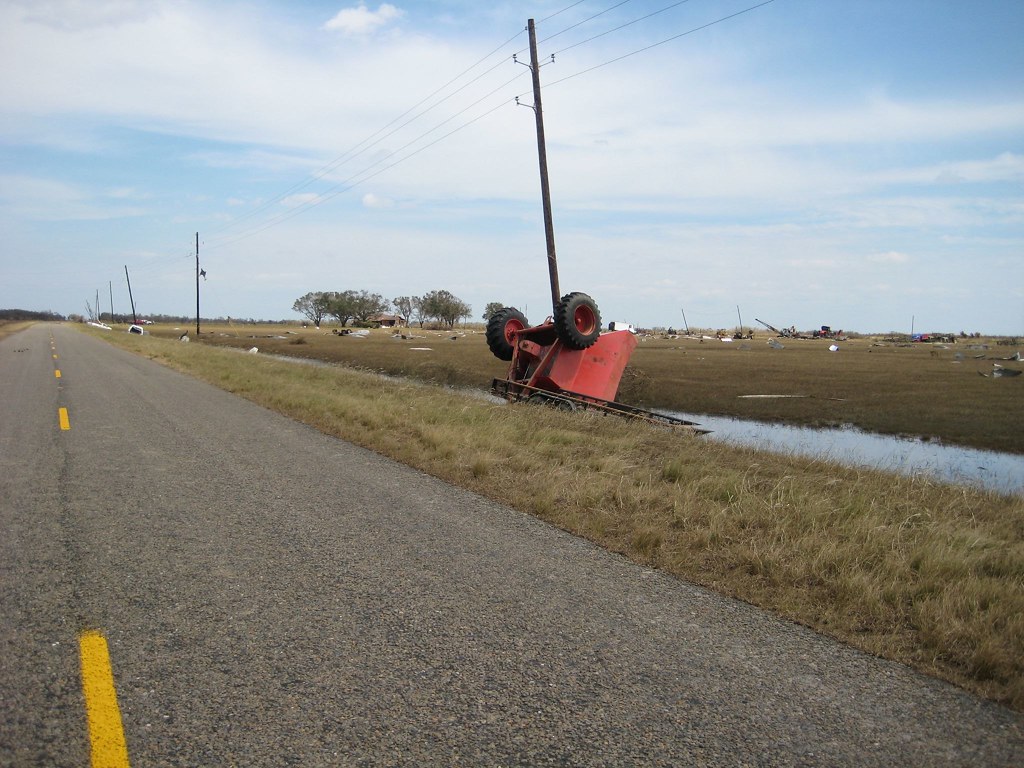 Just a couple of concrete slabs. A couple of pickup trucks and a large grain wagon were flipped over in the ditch across the street. Paul Mills, the engineer I was traveling with stopped next to a flooded shallow to show me some of the area's newest residents.
Just a couple of concrete slabs. A couple of pickup trucks and a large grain wagon were flipped over in the ditch across the street. Paul Mills, the engineer I was traveling with stopped next to a flooded shallow to show me some of the area's newest residents. 
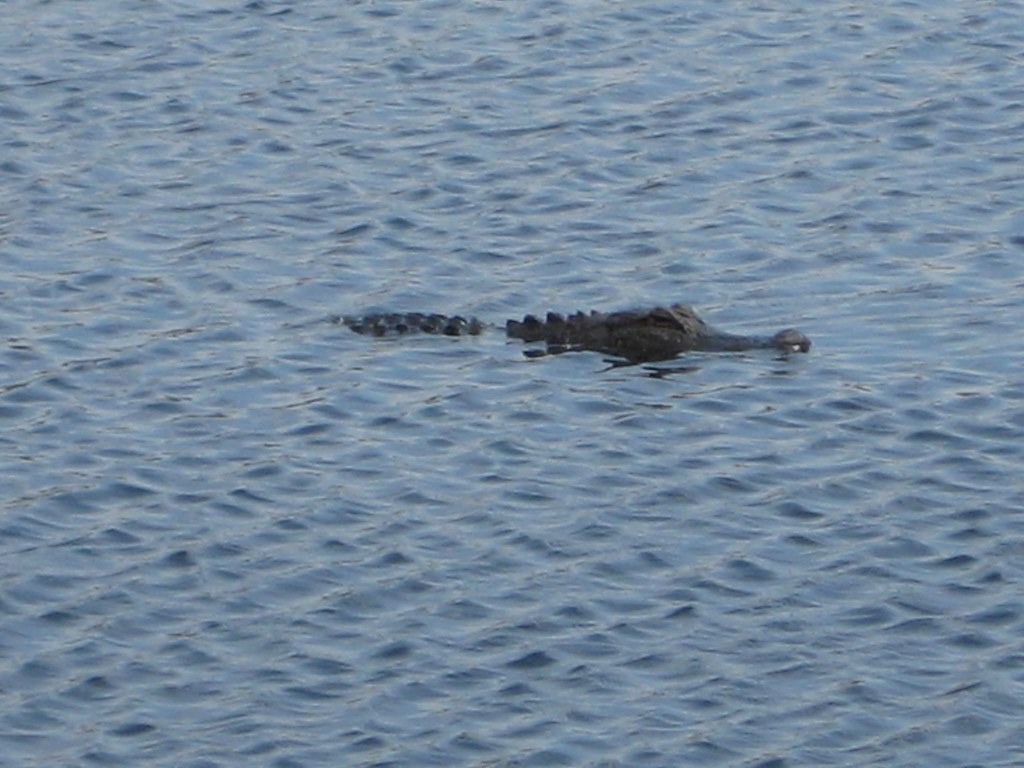
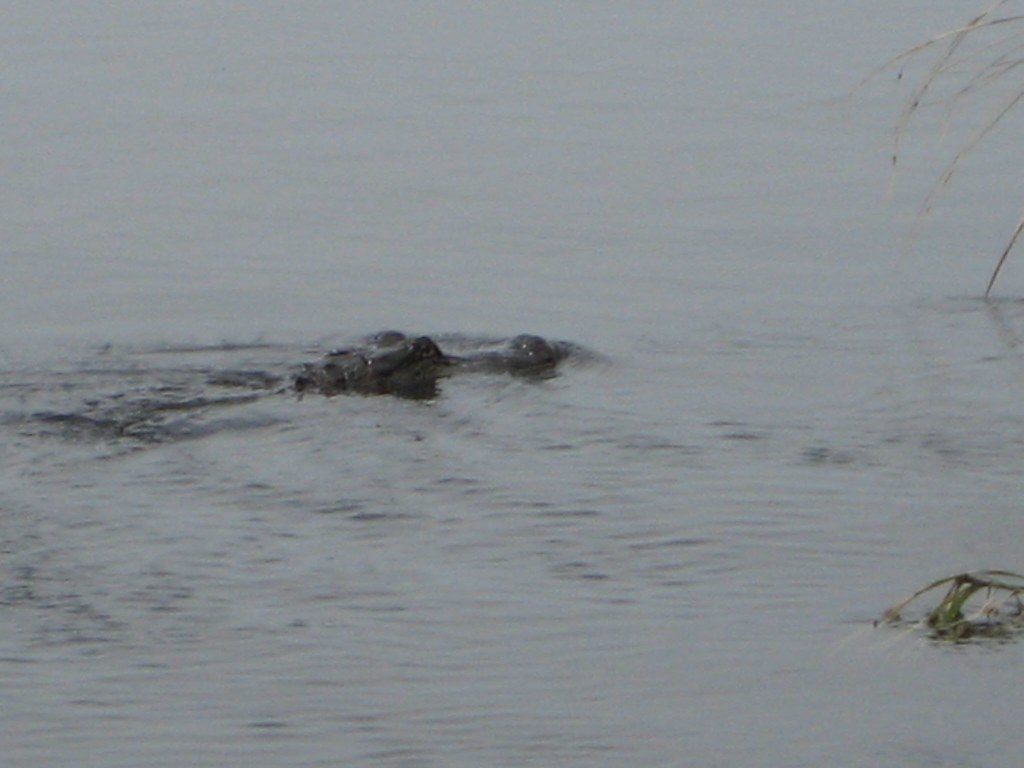
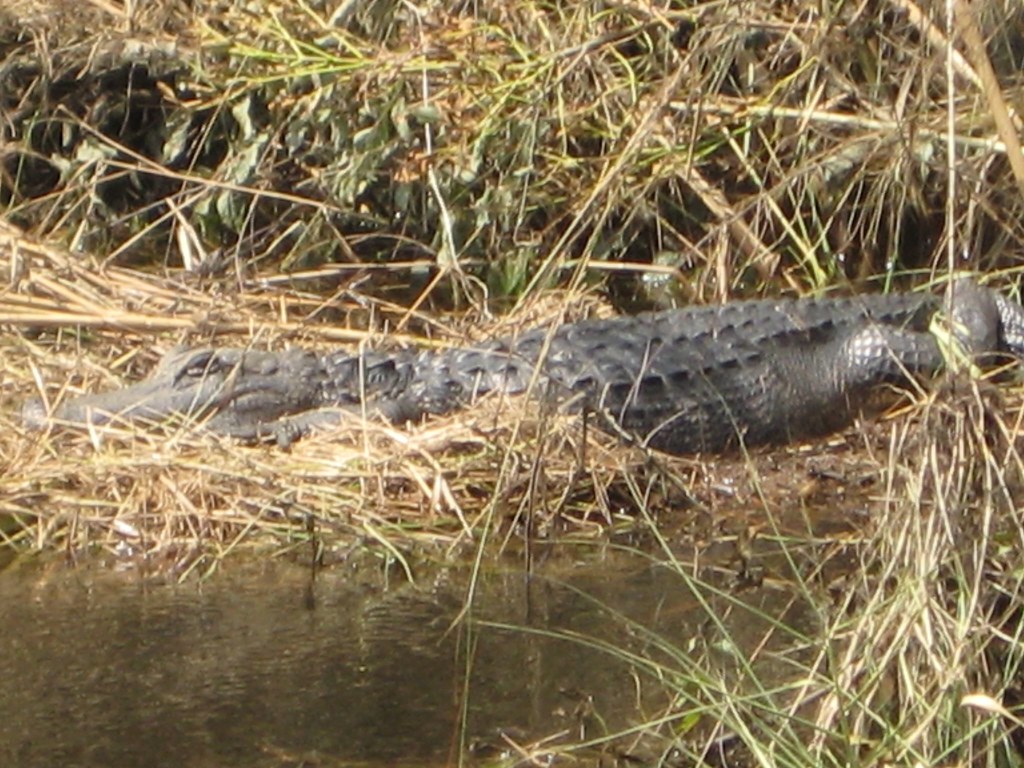
About half a dozen alligators were lounging on the banks of the water. The gators will have no shortage of food in the coming months, especially being scavengers. Fish, birds and other dead wildlife littered the road.
Eventually we came to the water in the road the officer had warned us about. We let a Texas DNR truck pass ahead of us through the water to see how deep it was. They seemed to make it through, so we cautiously proceeded to follow their path. It got a little dicey about 200 yards in when we had to make a right-hand turn, but had no idea where the road ended and where the ditch began. After clearing that we continued south to the Bolivar Peninsula. Before we could get to the town of High Island, we had to pass through another police checkpoint at the base of the intercoastal waterway bridge. Again they told us that we could pass, but we were on our own. This group of patrolmen was from El Paso. Troopers from all over the state flooded the region to keep order.
 From atop the bridge, you could see how far the marshes and pasture stretched. Because all of the land was right at sea level, it was all engulfed by the storm's surge. The above picture is facing west down the intercoastal waterway from Route 124.
From atop the bridge, you could see how far the marshes and pasture stretched. Because all of the land was right at sea level, it was all engulfed by the storm's surge. The above picture is facing west down the intercoastal waterway from Route 124.
Before we actually made it to the Bolivar Peninsula proper, we passed through the small town of High Island. I few of the residents that rode out the storm were conviened outside the local gas station. The town was battered, but most of the homes were still standing. There were also some new residents in the town. As I noted, much of the land in this area is dedicated to pasture. As the surge moved in, fences were knocked down. The surviving cattle were running free. The above picture is from an ATM in the middle of town.
The above picture is from an ATM in the middle of town.
The final leg of this journey was about 8 miles down the coast heading west/southwest. There were signs that the land along the road was once inhabited. We saw bed frames, lawn chairs, lots of refrigerators, but no houses. Driveways with posts and chains at the end, but no houses. Posts in the ground that served as supports for elevated houses, but no houses. It was a very erie drive. The road was basically one lane. The surge pushed enormous amounts of sand from the beach and gulf across the road. At one point the sand was so high, we had to drive off the road and through the support posts. Yes, a week earlier and we would have been driving under somebody's home. We eventually reached the SNG truck. Jaime, the operator Paul was relieving, was more than ready to get out of the area once he'd finished editing a package. The ride back was less nerve-wracking than the trip there. Knowing what was ahead we were able to head back steadily, but cautiously.
Back at the station they had one more assignment for me. The Harris County Precinct 7 Constable's station had been without power since before the storm, and the generator a generous citizen had loaned the department was about to go back to its home. Heading out to the dark section of town, I found a small area lit with construction lamps, powered by a generator. Some of the constable's deputies had been working straight through for the precinct with only the bottled water they'd bought on their own or been given by a community member. Through all of what they'd gone through, they had continued to serve and protect the citizens of their precinct to the best of their ability. I got their story to share with the rest of the community and maybe give county leaders an idea of where to focus their resources. That was my first day.
Wednesday, September 17, I headed into work at 9:00 am. I was scheduled to come in at 3:00, but with no power and not knowing anybody down there, what else was I going to do all day? Of course, they could use my help. Denise at the assignments desk paired me up with WABC reporter Carolina Leid. We were to head back out to Chambers County, not far from where I'd spent the previous day. We were told there was a small town called Double Bayou between Oak Island and Smith Point.
Heading that way we traveled east out I-10 again and again south on Route 61. We passed the same downed trees I'd seen the day before, but there was also progress on the power lines. Turning off of 61, the familiar sights continued. Much of the land that is Double Bayou is at sea level and though we were miles from the shoreline, you could see where the water had risen because the fences, trees and bushes alongside the road had a debris line all through them. Much of the debris looked like seaweed, but there were also pieces of tarps, curtains and clothing. It was hard to tell that some of the fences left standing were even fences, because the seaweed was so thick and tangled in them they looked like bushes or solid debris piles.

 A couple of the homes in the Double Bayou area damaged by either the surge or the winds.
A couple of the homes in the Double Bayou area damaged by either the surge or the winds.
We happened upon a family working outside their small farm cleaning up the debris and broken tree limbs scattered about their property. They thanked us for coming out to their part of the county, but they didn't feel comfortable talking on camera about their recovery from the storm. The family's daughter did tell us about what her Uncle Donny went through next door. According to the girl, Uncle Donny stayed in his home to ride out the storm, but as the storm surge moved inland and the waters continued to rise, Uncle Donny was forced to swim out the window and hunker down on the roof. He was rescued the following day by helicopter. We had to find Uncle Donny to hear his story.
We headed over to Uncle Donny's house only to find nobody was home. Uncle Donny is a constable and his patrol car did not survive the storm. It sat in the driveway and though its windows were fogged up, you could see the mud that coated everything inside. We decided to wait for a little while to see if Uncle Donny would show back up at his house. Half an hour later he still wasn't there, so we started to head out. We were stopped by a volunteer firefighter on our way out of town who said he knew Donny and could take us to him. Apparently he was working traffic in the neighboring town of Oak Island. Down the road we headed to Oak Island. We rolled up on the police checkpoint Uncle Donny was supposed to be working. The officer manning the stop told us that Donny had worked the night shift and was now in a shelter in the next county over getting some rest before his next shift.
Running out of time we decided we had to give up on Uncle Donny and get a story in the can. KTRK was broadcasting 24 hours a day without commericial breaks. We needed to get something on the air. Carolina remembered a woman she came across the day before in the town of Smith Point, not too far from where we were. The Britney Wood helped run her family's oyster business and was worried about whether or not the business would survive the storm. Off to Smith Point.
Smith Point is where the road ends, literally. Jeri's Seafood. Just off to the right when you come into town. It took us about 45 minutes to get there. We probably could have shaved off 15 minutes if the cattle weren't blocking the road. Real live cowboys were driving them into a holding area that's fence survived. I digress.
We met up with Britney at her house in Smith Point. We did part of the interview at her house before going back into town to conclude the interview at Jeri's Seafood headquarters. Britney was very concerned for the family business. She figures they employ about 120 people, and if the oyster harvest had been comprimised, they employee's jobs could be in jeopardy. Britney was also feeling some survivor's guilt.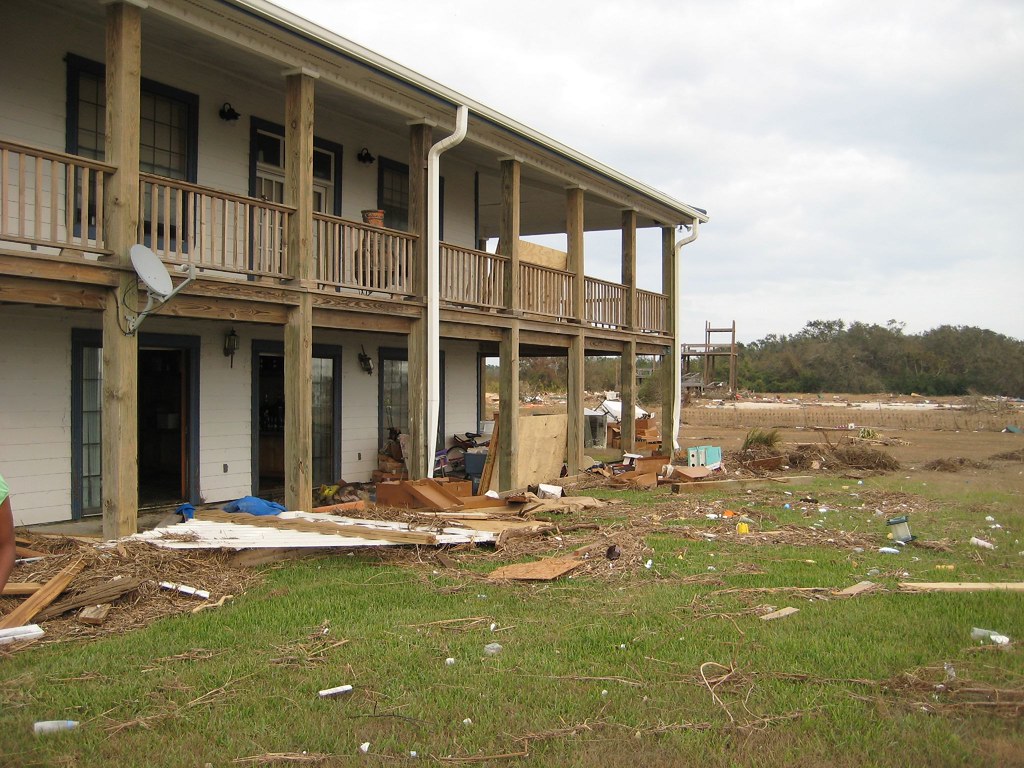 Her waterfront home, as well as her mother's, survived the storm with damage to only the first floor - even though the surge moved right through her house.
Her waterfront home, as well as her mother's, survived the storm with damage to only the first floor - even though the surge moved right through her house.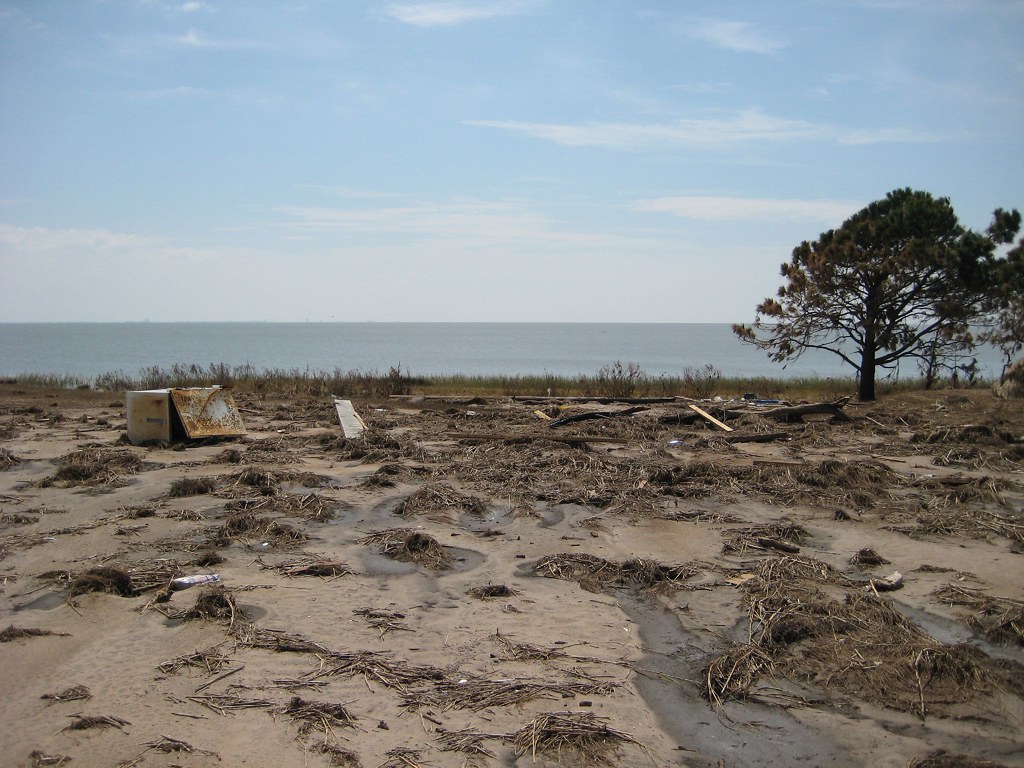
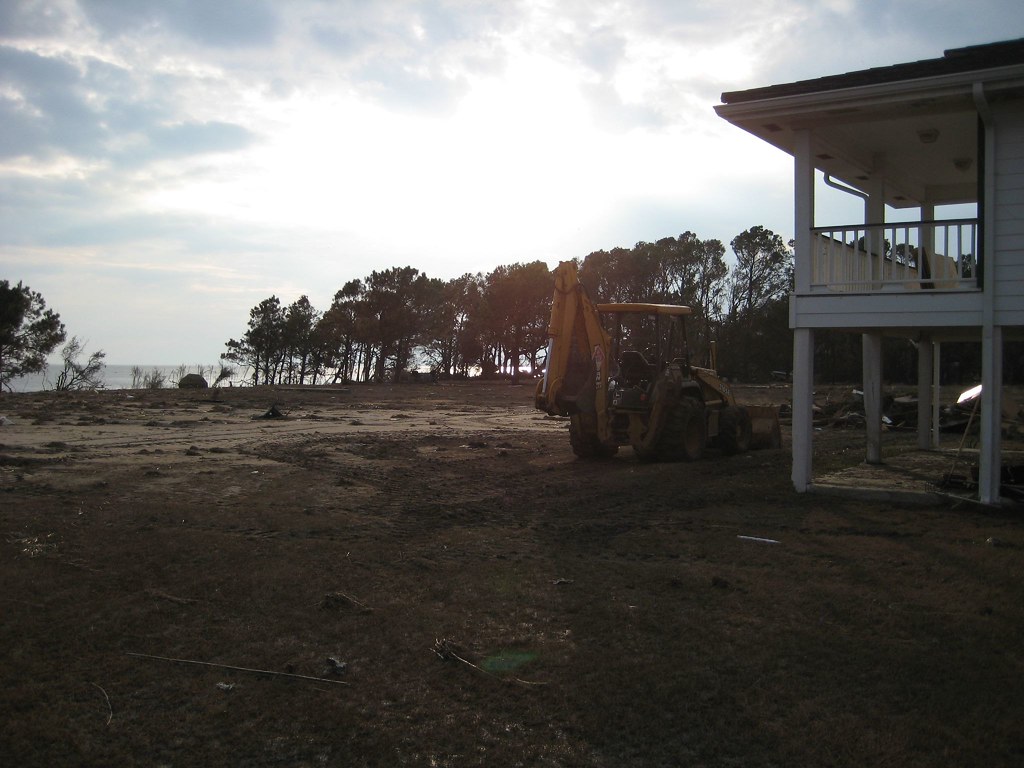 Britney and her mother's yards were littered with the debris from homes miles away across the bay on the Bolivar Peninsula.
Britney and her mother's yards were littered with the debris from homes miles away across the bay on the Bolivar Peninsula.

 We did start to notice more of the storm's casualties in the smith point area. Two wild hogs laid dead along the road and the number of dead cattle we'd seen was increasing.
We did start to notice more of the storm's casualties in the smith point area. Two wild hogs laid dead along the road and the number of dead cattle we'd seen was increasing.
After I'd finished editing the package, it was sent to both KTRK and WABC.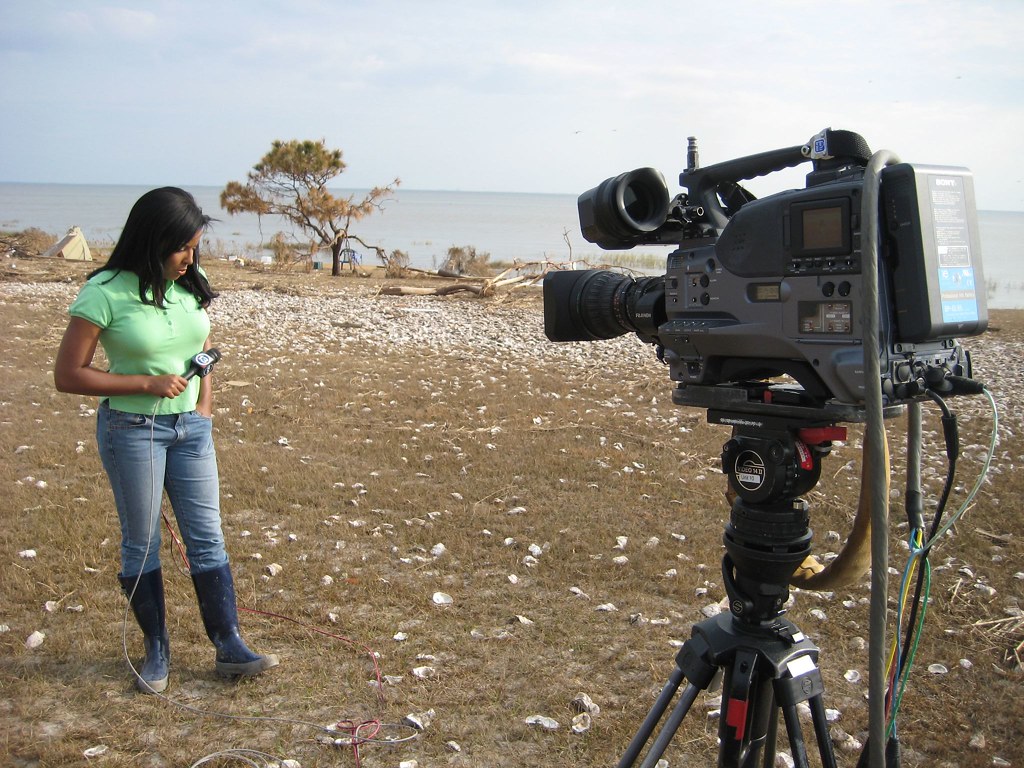
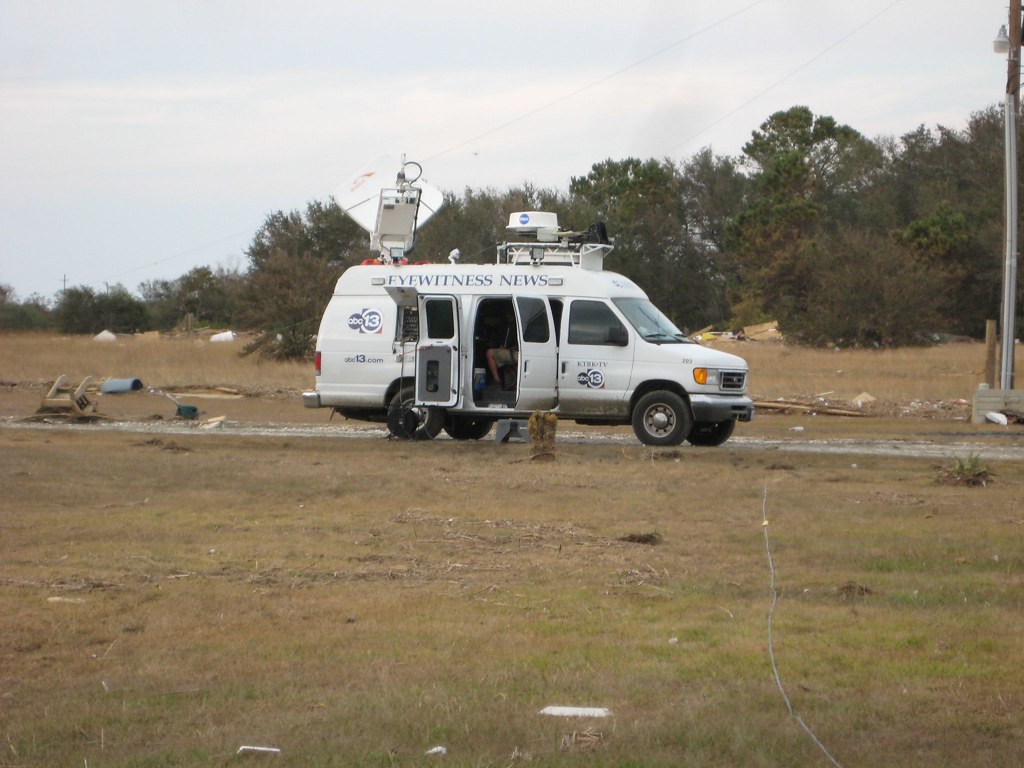
 We did the live shot for WABC and then had about an hour of down time.
We did the live shot for WABC and then had about an hour of down time. 
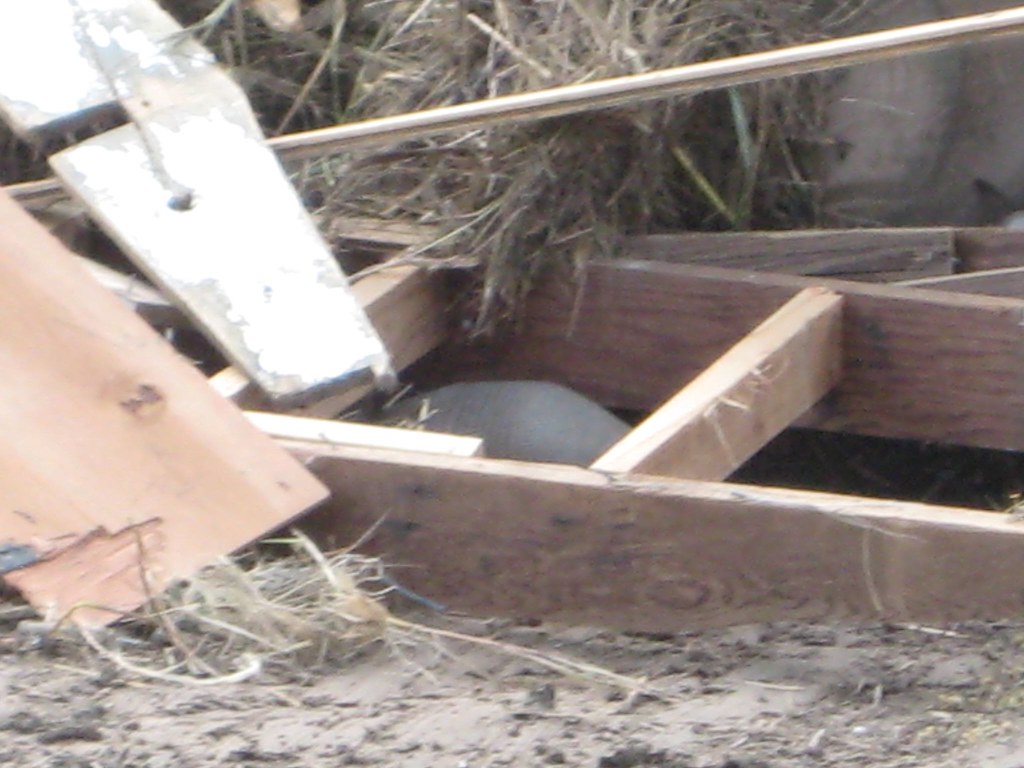 An armadillo stopped by to visit and rummage through the debris scattered about the yard.
An armadillo stopped by to visit and rummage through the debris scattered about the yard.
Here is our report from Smith Point.
STANDBY="Loading Windows Media Player components..." TYPE="application/x-oleobject">
WIDTH="192" HEIGHT="190" ShowControls="1" ShowStatusBar="0" ShowDisplay="0" autostart="0">
This post is getting too long. I'll follow up with the rest of my trip soon.
Thanks for watching.
-Billau
*Forgive me for any typos. This post was too long for spell check to work properly.
Kevin and I flew into Houston Monday night. We checked into the station around 10:30 central time. After saying hello to a couple of people we remembered from the last trip, we checked our schedules for the next day and checked into our hotel.
Tuesday morning I arrived at KTRK at 8 am.
 Kevin and Jeff would be working together all week. I was not assigned a reporter. My first task was to go downtown to the Morgan Chase Tower to check the progress of the cleanup in the area. The building is the tallest in the city and a number of its windows were knocked out during the hurricane. There was still very little power in the city, with most of the traffic lights being out they were now four-way stops. Adding to the difficulty were the police roadblocks. Entire city blocks were shut down so that heavy machinery could come in and clear the glass and debris. I talked to a bartender who was back to work for the first time since the storm. A lifelong Houstonian, he'd never seen the city try to recover from something like this.
Kevin and Jeff would be working together all week. I was not assigned a reporter. My first task was to go downtown to the Morgan Chase Tower to check the progress of the cleanup in the area. The building is the tallest in the city and a number of its windows were knocked out during the hurricane. There was still very little power in the city, with most of the traffic lights being out they were now four-way stops. Adding to the difficulty were the police roadblocks. Entire city blocks were shut down so that heavy machinery could come in and clear the glass and debris. I talked to a bartender who was back to work for the first time since the storm. A lifelong Houstonian, he'd never seen the city try to recover from something like this.My next job for the station was chauffeur. KTRK had stationed a crew out on the Bolivar Peninsula, an area that took a direct hit from Ike. My job was to run a satellite truck operator out to the live location to relieve the operator who'd been stationed there for 48 hours. My new GPS told me the trip from Houston to the peninsula would take about an hour and a half. We left a twelve-thirty. We pulled up to the satellite truck about three-forty five. What I saw on that ride was incredible. As we headed east out I-10, we started to see the full force of this hurricane. Part of I-10 is lies very close to sea level.
 Officials had to use plow trucks to remove the debris the storm surge washed onto the highway. For a 2 mile stretch, there was a 6 foot pile of debris lined up just off the shoulder. Billboards were skeletons with the tattered banners blowing in the wind. It was difficult to know where exits were because the signs were blown off the posts.
Officials had to use plow trucks to remove the debris the storm surge washed onto the highway. For a 2 mile stretch, there was a 6 foot pile of debris lined up just off the shoulder. Billboards were skeletons with the tattered banners blowing in the wind. It was difficult to know where exits were because the signs were blown off the posts. We stopped to get toilet paper and paper towels at the one open gas station we passed along the way.

 Several state troopers were directing traffic to the pumps and the line was hundreds of yards long.
Several state troopers were directing traffic to the pumps and the line was hundreds of yards long. Next to the gas station there used to be a farm stand that sold vegetables.

 Ike's winds damaged the stand pretty badly.
Ike's winds damaged the stand pretty badly.When we got to Route 61 we headed south, and that's where I started to realize the force that this hurricane had. Heading down HWY 61 was like driving through another world. I can't tell you how many times we drove over power lines that were strewn across the road, I quit counting at 25. Trees, huge trees were either snapped in half of ripped right from the ground in which they stood.


 We passed countless boom trucks that power companies from all over the country had dispatched to help with the recovery. Rarely did we see a telephone pole that was not leaning, on its side or snapped in half by Ike's winds. At a police checkpoint, a Texas state trooper needed to see identification for us to travel through. Last he'd heard, the road we'd planned to travel was under water, but we could continue at our own risk. After the checkpoint, our journey took us through a marshy, pasture mix of Chambers County.
We passed countless boom trucks that power companies from all over the country had dispatched to help with the recovery. Rarely did we see a telephone pole that was not leaning, on its side or snapped in half by Ike's winds. At a police checkpoint, a Texas state trooper needed to see identification for us to travel through. Last he'd heard, the road we'd planned to travel was under water, but we could continue at our own risk. After the checkpoint, our journey took us through a marshy, pasture mix of Chambers County.  Metal silos stood like crushed soda cans, a testament to the force of Ike's winds. At one point we passed what used to be a farm. The house and barns were no longer there.
Metal silos stood like crushed soda cans, a testament to the force of Ike's winds. At one point we passed what used to be a farm. The house and barns were no longer there. 


 Just a couple of concrete slabs. A couple of pickup trucks and a large grain wagon were flipped over in the ditch across the street. Paul Mills, the engineer I was traveling with stopped next to a flooded shallow to show me some of the area's newest residents.
Just a couple of concrete slabs. A couple of pickup trucks and a large grain wagon were flipped over in the ditch across the street. Paul Mills, the engineer I was traveling with stopped next to a flooded shallow to show me some of the area's newest residents. 



About half a dozen alligators were lounging on the banks of the water. The gators will have no shortage of food in the coming months, especially being scavengers. Fish, birds and other dead wildlife littered the road.
Eventually we came to the water in the road the officer had warned us about. We let a Texas DNR truck pass ahead of us through the water to see how deep it was. They seemed to make it through, so we cautiously proceeded to follow their path. It got a little dicey about 200 yards in when we had to make a right-hand turn, but had no idea where the road ended and where the ditch began. After clearing that we continued south to the Bolivar Peninsula. Before we could get to the town of High Island, we had to pass through another police checkpoint at the base of the intercoastal waterway bridge. Again they told us that we could pass, but we were on our own. This group of patrolmen was from El Paso. Troopers from all over the state flooded the region to keep order.
 From atop the bridge, you could see how far the marshes and pasture stretched. Because all of the land was right at sea level, it was all engulfed by the storm's surge. The above picture is facing west down the intercoastal waterway from Route 124.
From atop the bridge, you could see how far the marshes and pasture stretched. Because all of the land was right at sea level, it was all engulfed by the storm's surge. The above picture is facing west down the intercoastal waterway from Route 124.Before we actually made it to the Bolivar Peninsula proper, we passed through the small town of High Island. I few of the residents that rode out the storm were conviened outside the local gas station. The town was battered, but most of the homes were still standing. There were also some new residents in the town. As I noted, much of the land in this area is dedicated to pasture. As the surge moved in, fences were knocked down. The surviving cattle were running free.
 The above picture is from an ATM in the middle of town.
The above picture is from an ATM in the middle of town.The final leg of this journey was about 8 miles down the coast heading west/southwest. There were signs that the land along the road was once inhabited. We saw bed frames, lawn chairs, lots of refrigerators, but no houses. Driveways with posts and chains at the end, but no houses. Posts in the ground that served as supports for elevated houses, but no houses. It was a very erie drive. The road was basically one lane. The surge pushed enormous amounts of sand from the beach and gulf across the road. At one point the sand was so high, we had to drive off the road and through the support posts. Yes, a week earlier and we would have been driving under somebody's home. We eventually reached the SNG truck. Jaime, the operator Paul was relieving, was more than ready to get out of the area once he'd finished editing a package. The ride back was less nerve-wracking than the trip there. Knowing what was ahead we were able to head back steadily, but cautiously.
Back at the station they had one more assignment for me. The Harris County Precinct 7 Constable's station had been without power since before the storm, and the generator a generous citizen had loaned the department was about to go back to its home. Heading out to the dark section of town, I found a small area lit with construction lamps, powered by a generator. Some of the constable's deputies had been working straight through for the precinct with only the bottled water they'd bought on their own or been given by a community member. Through all of what they'd gone through, they had continued to serve and protect the citizens of their precinct to the best of their ability. I got their story to share with the rest of the community and maybe give county leaders an idea of where to focus their resources. That was my first day.
Wednesday, September 17, I headed into work at 9:00 am. I was scheduled to come in at 3:00, but with no power and not knowing anybody down there, what else was I going to do all day? Of course, they could use my help. Denise at the assignments desk paired me up with WABC reporter Carolina Leid. We were to head back out to Chambers County, not far from where I'd spent the previous day. We were told there was a small town called Double Bayou between Oak Island and Smith Point.
Heading that way we traveled east out I-10 again and again south on Route 61. We passed the same downed trees I'd seen the day before, but there was also progress on the power lines. Turning off of 61, the familiar sights continued. Much of the land that is Double Bayou is at sea level and though we were miles from the shoreline, you could see where the water had risen because the fences, trees and bushes alongside the road had a debris line all through them. Much of the debris looked like seaweed, but there were also pieces of tarps, curtains and clothing. It was hard to tell that some of the fences left standing were even fences, because the seaweed was so thick and tangled in them they looked like bushes or solid debris piles.

 A couple of the homes in the Double Bayou area damaged by either the surge or the winds.
A couple of the homes in the Double Bayou area damaged by either the surge or the winds.We happened upon a family working outside their small farm cleaning up the debris and broken tree limbs scattered about their property. They thanked us for coming out to their part of the county, but they didn't feel comfortable talking on camera about their recovery from the storm. The family's daughter did tell us about what her Uncle Donny went through next door. According to the girl, Uncle Donny stayed in his home to ride out the storm, but as the storm surge moved inland and the waters continued to rise, Uncle Donny was forced to swim out the window and hunker down on the roof. He was rescued the following day by helicopter. We had to find Uncle Donny to hear his story.
We headed over to Uncle Donny's house only to find nobody was home. Uncle Donny is a constable and his patrol car did not survive the storm. It sat in the driveway and though its windows were fogged up, you could see the mud that coated everything inside. We decided to wait for a little while to see if Uncle Donny would show back up at his house. Half an hour later he still wasn't there, so we started to head out. We were stopped by a volunteer firefighter on our way out of town who said he knew Donny and could take us to him. Apparently he was working traffic in the neighboring town of Oak Island. Down the road we headed to Oak Island. We rolled up on the police checkpoint Uncle Donny was supposed to be working. The officer manning the stop told us that Donny had worked the night shift and was now in a shelter in the next county over getting some rest before his next shift.
Running out of time we decided we had to give up on Uncle Donny and get a story in the can. KTRK was broadcasting 24 hours a day without commericial breaks. We needed to get something on the air. Carolina remembered a woman she came across the day before in the town of Smith Point, not too far from where we were. The Britney Wood helped run her family's oyster business and was worried about whether or not the business would survive the storm. Off to Smith Point.
Smith Point is where the road ends, literally. Jeri's Seafood. Just off to the right when you come into town. It took us about 45 minutes to get there. We probably could have shaved off 15 minutes if the cattle weren't blocking the road. Real live cowboys were driving them into a holding area that's fence survived. I digress.
We met up with Britney at her house in Smith Point. We did part of the interview at her house before going back into town to conclude the interview at Jeri's Seafood headquarters. Britney was very concerned for the family business. She figures they employ about 120 people, and if the oyster harvest had been comprimised, they employee's jobs could be in jeopardy. Britney was also feeling some survivor's guilt.
 Her waterfront home, as well as her mother's, survived the storm with damage to only the first floor - even though the surge moved right through her house.
Her waterfront home, as well as her mother's, survived the storm with damage to only the first floor - even though the surge moved right through her house.
 Britney and her mother's yards were littered with the debris from homes miles away across the bay on the Bolivar Peninsula.
Britney and her mother's yards were littered with the debris from homes miles away across the bay on the Bolivar Peninsula. 
 We did start to notice more of the storm's casualties in the smith point area. Two wild hogs laid dead along the road and the number of dead cattle we'd seen was increasing.
We did start to notice more of the storm's casualties in the smith point area. Two wild hogs laid dead along the road and the number of dead cattle we'd seen was increasing. After I'd finished editing the package, it was sent to both KTRK and WABC.


 We did the live shot for WABC and then had about an hour of down time.
We did the live shot for WABC and then had about an hour of down time. 
 An armadillo stopped by to visit and rummage through the debris scattered about the yard.
An armadillo stopped by to visit and rummage through the debris scattered about the yard.Here is our report from Smith Point.
STANDBY="Loading Windows Media Player components..." TYPE="application/x-oleobject">
WIDTH="192" HEIGHT="190" ShowControls="1" ShowStatusBar="0" ShowDisplay="0" autostart="0">
This post is getting too long. I'll follow up with the rest of my trip soon.
Thanks for watching.
-Billau
*Forgive me for any typos. This post was too long for spell check to work properly.
Subscribe to:
Posts (Atom)

